- Link to facebook
- Link to linkedin
- Link to twitter
- Link to youtube
- Writing Tips

How to Write the Date in an Essay

- 3-minute read
- 4th February 2016
You probably see the date written down (or displayed on a screen) dozens of times every day. You might even have to write it out yourself if you’re booking an appointment or organising your schedule.
Despite this, most of us give very little thought to how we write the date. In academic writing and other formal contexts , however, it’s important to use a clear and consistent format.
Different Formats
The most important thing to remember when writing the date is that, in the UK and throughout most of the world, we favour a day-month-year format (otherwise known as the little-endian sequence ). This can be presented in numerous ways, including:
- Day + Month (e.g. 21 April)
- Day + Month + Year (e.g., 21 April 2016)
- Numbers Only (e.g. 21/04/2016)
There are also variations to how these can be presented, such as using an ordinal suffix after the day. These are the letters we’d use if we were writing the number out in full and are often written with a superscript font:
We last spoke on the 21st of April.
The meetings will be held on the 2 nd of February and the 13 th June.
Sometimes, the month in the date can be shortened to save space:
14 January 2012 → 14 Jan. 2012
9 October → 9 Oct.
However, generally in formal writing it’s better to use the longer format for clarity. Likewise, when including a date in an essay you should usually write it out (e.g. 21 April 2016) rather than use the numbers-only style.
Find this useful?
Subscribe to our newsletter and get writing tips from our editors straight to your inbox.
Check Your Style Guide and Be Consistent
Since there are various ways of writing the date, you should always check your university’s style guide to see if a preferred format is specified. If it doesn’t offer any particular advice, simply pick a clear format that suits you and make sure to use it consistently for all dates in your essay.
UK vs. American Dates
The other thing to keep in mind when writing (and reading) dates is how the US date format differs from ours. In America, dates use a month-day-year format, which can lead to problems when they are written out in numbers only as days and months get confused.
The US date format also places a comma between the day and year when both are numbers, as well as omitting superscript letters. The only time you would use superscript letters after the day in the US date format is when writing it out in full as, e.g., the 10 th of September.
You can see a few examples of UK and US dates below:
| 07 April 2016 (07/04/2016) | April 07, 2016 (04/07/2016) |
| 11 December 2013 (11/12/13) | December 11, 2013 (12/11/13) |
| 4 January 1945 (4/1/1945) | January 4, 1945 (1/4/1945) |
As you can see, the date ‘07/04/2016’ represents the 7th of April 2016 in the UK, but the same numbers indicate the 4th of July in America! Take care about which format you use when writing for international audiences.
The International Date Format
Finally, if you’re sharing information across the world, you may want to use the international date format (ISO 8601) . This is a standardized format that works across borders, so it is commonly used by government organizations and global businesses. And it always uses the format YYYY-MM-DD, which removes any chance of confusion:
We sent the invoice on 2020-07-10 .
The date above, for example, denotes the 10th of July 2020.
Expert Proofreading
If you want to be sure the dates in your documents are always clear and correct, don’t forget to have your writing proofreading. Submit a trial document for free today to find out more.
Share this article:
Post A New Comment
Get help from a language expert. Try our proofreading services for free.
5-minute read
Free Email Newsletter Template (2024)
Promoting a brand means sharing valuable insights to connect more deeply with your audience, and...
6-minute read
How to Write a Nonprofit Grant Proposal
If you’re seeking funding to support your charitable endeavors as a nonprofit organization, you’ll need...
9-minute read
How to Use Infographics to Boost Your Presentation
Is your content getting noticed? Capturing and maintaining an audience’s attention is a challenge when...
8-minute read
Why Interactive PDFs Are Better for Engagement
Are you looking to enhance engagement and captivate your audience through your professional documents? Interactive...
7-minute read
Seven Key Strategies for Voice Search Optimization
Voice search optimization is rapidly shaping the digital landscape, requiring content professionals to adapt their...
How to Ace Slack Messaging for Contractors and Freelancers
Effective professional communication is an important skill for contractors and freelancers navigating remote work environments....

Make sure your writing is the best it can be with our expert English proofreading and editing.

How to Write the Date (21 Examples + Detailed Guide)
Writing the date might seem straightforward, but different situations require different formats. Whether you’re writing a formal letter, filling out a check, or citing a source in MLA format, knowing how to properly write the date is essential.
This guide will provide detailed explanations and examples for 21 different scenarios, ensuring you have the most comprehensive resource available.
21 Ways to Write the Date (Fully Explained)

Writing the date correctly can depend on the context, culture, and purpose.
Different scenarios require different formats to ensure clarity and avoid confusion. Here are 21 ways to write the date, explained in detail with examples.
1. Formal English
In formal English, especially in business or academic writing, the date is typically written in full to avoid ambiguity.
This format includes the day of the month, the month spelled out in full, and the year.
Using ordinal numbers (e.g., 1st, 2nd, 3rd) is optional but common in formal contexts.
This method ensures that the date is clear and easily understood by readers, regardless of their regional date format preferences.
- Correct : 15th July 2023
- Correct : July 15, 2023
- Incorrect : 07/15/23
2. With Words
Writing the date entirely in words adds a formal touch to invitations, letters, or legal documents.
This format spells out both the day and the year in full, making the date clear and unambiguous. It’s commonly used in formal invitations, contracts, and other legal documents where precision is crucial.
- Fifteenth of July, Two Thousand Twenty-Three
- Twenty-Fourth of December, Two Thousand Nineteen
- First of January, Two Thousand Twenty-One
3. On a Check
Writing the date on a check requires a specific format to ensure clarity and legality.
This typically involves writing out the month in full, followed by the day and the complete year. This prevents any confusion that might arise from regional differences in date formatting.
- July 15, 2023
- December 1, 2023
- February 28, 2023
4. In MLA Format
When writing a paper in MLA format, the date is typically written in the day-month-year format without commas.
This format is used to maintain consistency and clarity throughout academic papers.
It ensures that the date is easily readable and follows the standard guidelines set by the Modern Language Association.
- 15 July 2023
- 24 December 2019
- 1 January 2021
5. In French
Writing the date in French follows a different order than in English, with the day preceding the month and the month not capitalized.
This format is standard in French-speaking countries and is essential for maintaining cultural and linguistic accuracy in documents, letters, and other communications.
- 15 juillet 2023
- 24 décembre 2019
- 1 janvier 2021
6. In British English
British English typically follows the day-month-year format, similar to formal English.
This format helps avoid the confusion that can arise from the month-day-year format used in American English.
It’s widely used in the UK for everything from letters and emails to official documents.
7. In American English
American English often uses the month-day-year format, which is standard in the United States.
This format can sometimes cause confusion internationally, so it’s important to specify the context if your document will be read by a global audience.
- December 24, 2019
- January 1, 2021
Check out this video about how to write the date in American English:
8. In ISO Format
The ISO 8601 format is an international standard for date and time representations, ensuring clarity and avoiding confusion across different regions. It’s commonly used in technical fields, databases, and software development.
9. In a Resume
Writing the date on a resume should be clear and concise, often following a month-year format. This format keeps the resume clean and focuses on the timeline of your employment or education history without unnecessary clutter.
- December 2019
- January 2021
10. In Legal Documents
Legal documents require precise date formats to avoid any ambiguity.
Dates are often spelled out in full to ensure there is no confusion or misinterpretation. This method is used to maintain the legal integrity and clarity of the document.
- Fifteenth day of July, Two Thousand Twenty-Three
- Twenty-Fourth day of December, Two Thousand Nineteen
- First day of January, Two Thousand Twenty-One
11. In an Invitation
Invitations often use a more formal date format to match the tone of the event. This can include spelling out the day of the week and the date in full, adding a touch of elegance and formality to the invitation.
- Saturday, the Fifteenth of July, Two Thousand Twenty-Three
- Tuesday, the Twenty-Fourth of December, Two Thousand Nineteen
- Friday, the First of January, Two Thousand Twenty-One
12. In a Report
Writing the date in a report should be clear and precise, often following the day-month-year format.
This format is straightforward and avoids any potential confusion, making the date easily understandable.
13. In a Diary or Journal
Personal diaries or journals can use any format, but consistency is key.
Choose a format that you prefer and stick with it throughout your entries to maintain a coherent record of your thoughts and activities.
- 15th July 2023
14. In Academic Writing
Academic writing often follows specific style guides, such as APA or Chicago, each with its own date format.
Following the required style guide ensures your work adheres to academic standards.
Examples (APA):
Examples (Chicago):
15. In an Email
Writing the date in an email can be more flexible but should still be clear to avoid any potential misunderstandings.
The month-day-year format is common in many regions and easily understood in most contexts, making it a good choice for emails.
Whether you’re sending a professional email or a casual message, clarity is key.
The format you choose can depend on your audience; for international recipients, you might want to use a more universally recognized format to ensure comprehension.
Additionally, placing the date at the beginning of your email or in the subject line can help provide context for your message.
16. In a Blog Post
Blog posts should use a clear date format to ensure readers can easily understand the timeline.
The month-day-year format is straightforward and familiar to most readers, making it a good choice for blog posts.
This format helps to avoid confusion and provides a consistent look throughout your content.
Dates in blog posts can indicate when the post was published or last updated, which can be crucial for readers looking for the most current information. A prominently displayed date can also enhance the credibility of your content.
17. In a Business Letter
Business letters often use a formal date format at the top of the letter.
The day-month-year format is formal and avoids any ambiguity, making it suitable for business correspondence.
This format aligns with international standards and is less likely to cause confusion.
Including the date at the beginning of a business letter is essential for record-keeping and for providing a timeline of correspondence.
It also sets a professional tone, ensuring that the letter is taken seriously by its recipients.
18. In a Personal Letter
Personal letters can use a more casual date format, depending on the preference of the writer.
Whether you choose the day-month-year format or the month-day-year format, consistency is key.
Personal letters are more flexible, and the date format can reflect the informality or formality of the relationship.
Using a familiar format can make the letter feel more personalized and relatable.
The date in a personal letter helps the recipient place the letter in a specific time context, which can be especially meaningful in ongoing correspondence.
19. On a Form
Forms often require specific date formats to ensure consistency and clarity.
Following the format specified on the form is crucial to ensure your date is recorded correctly.
This is especially important for legal documents, medical records, or any official paperwork where accuracy is paramount.
Forms may require different formats, such as MM/DD/YYYY or DD/MM/YYYY, and adhering to these requirements can prevent errors and processing delays. Ensuring the correct format helps maintain the integrity of the data and facilitates efficient handling of the form.
- 07/15/2023 (MM/DD/YYYY)
- 15/07/2023 (DD/MM/YYYY)
- 2023-07-15 (YYYY-MM-DD)
20. In Technical Writing
Technical writing often follows the ISO 8601 format for clarity and consistency.
The ISO format, YYYY-MM-DD, is precise and avoids any regional variations, making it ideal for technical documents.
This format is used in documentation, software development, and scientific research to ensure dates are interpreted correctly regardless of the reader’s locale.
Using the ISO format helps maintain a high standard of clarity and avoids potential misinterpretations.
21. In a Greeting Card
Greeting cards can use a more decorative and personalized date format.
Adding a touch of personalization to the date format can make the card feel more special and thoughtful.
Using formats that include the day of the week or fully spelled-out dates can enhance the card’s sentimental value. This can be particularly effective for special occasions like birthdays, anniversaries, or holidays, where the date is part of the celebration.
- July 15th, 2023
- Saturday, the Fifteenth of July, 2023
Final Thoughts: How to Write a Date
Simple questions and complete answers is what this website is all about.
I hope this guide answers all the questions you may have now or in the future about how to write a date.
For even more guides, check out some of the topics below and don’t forget to subscribe to my email newsletter so that you don’t miss any new articles in the future.
Read This Next
- How to Write a Check [Ultimate Guide + 20 Examples]
- How to Write an Abstract (Ultimate Guide + 13 Examples)
- How to Write on a PDF (13 Easy Ways for Beginners)
- How to Write a Letter of Intent [Tips, Examples, Templates]
- How to Write an Email (Ultimate Guide + 60 Examples)
How to Write Dates Correctly (With Examples)

Writing dates can seem straightforward at times and confounding at others. This complexity in writing dates arises due to the different formats used worldwide. Many authors also get confused about how to write them using commas. Understanding the established standards and then applying them consistently and clearly are the keys to conquering this difficulty with dates.
Continue reading to learn how to format dates in American English.
Different methods for writing dates
There are several methods for writing dates that are accepted internationally.
Follow dialectical standards
- When using American English, the month should precede the day. First, write the month, then the day, and then the year. Examples are:
- September 10
- When using American English, separate the day and the year using a comma . If you are including the weekday, place a comma after it as well. A comma is not required if you are using British English. Examples are:
- September 10, 2022
- September tenth, 2022
- Saturday , September 10, 2022
- When using British English, the day should precede the month. This system is followed in many nations, including the UK and Australia. First, write the day, then the month, and then the year. Examples are:
- 10th September
- 10 September 2022
- Saturday the 10th of September 2022.
- When using British English, use “of” and “the.” The “of” and “the” should precede the month and day, respectively. It is also crucial to use them both together. Examples are:
- The 10th of September
- Saturday the tenth of September
- When using British English, the day should be followed by ordinal indicators. Use one ordinal indicator like -st, -th, -nd, or -rd that matches the suffix . Though not commonly followed, this format is still accepted in American English. Examples are:
- The 21st of September
- The 14th of September
- The 2nd of September
- The 3rd of September
- When writing for an international audience, use the International Standard to prevent confusion. In this format, first write the year, then the month, and then the day. Commas are not used and all four digits of the year are written. Examples are:
- 2022 September 10
Use different degrees of scope and formality
- When writing extremely formal invitations, be sure to spell the year, month, and day. The day should be written first even when you are using American English. This format is used for official certificates like diplomas and documents with the highest formalities, including wedding invitations. It is used to show deference and courtesy to the occasion and the reader.
- We request the presence of you and your family on the tenth of September in the year three thousand and thirty.
- When communicating in a semi-formal or slightly formal setting, spell only the month out. It is appropriate to use digits for the year and the day. This format is prevalent in academic writing. There is also a slight variation in the writing style depending on whether you use American or British English.
- For American English: “Queen Elizabeth II ascended the English throne on June 2, 1953.” or “Queen Elizabeth II ascended the English throne in June 1953.”
- For British English: “Queen Elizabeth II ascended the English throne on 2 June 1953.” or “Queen Elizabeth II ascended the English throne on 2nd of June 1953.”
- Use numerals when writing dates on records and documents. This format is usually followed for memos, impersonal business records like invoices or a piece of communication, or even on lecture notes. This is done to show when the document was made or when it is due. Use all numerals when filling out forms and keeping records. Points to note in this format:
- When writing greeting cards, use the MM/DD/YY format and write the date at the top. This will help the receiver know when the card was written. Example: 09/10/22.
- The YYYY-MM-DD pattern is usually used in museum databases to indicate the date an artifact was obtained. Example: 2022-09-10.
- When filling out government forms, use the MM-DD-YYYY format. Example: 09-10-2022.
Format for numerical dates
- Separate the numerals indicating the day, month, and year using hyphens or slashes. For a more elegant look, bullets or periods can also be used. Underscores are also used in some cases. Always use hyphens when writing in an international format. When using American English, the date September 10, 1992, can be written as:
- In international standards, it is written as 1992-10-09
- A writer can optionally add “0” when the day or month is a single-digit number. Although it is frequently necessary on forms, many forgo it in daily informal settings. Using this format will ensure that the numerical dates all have equal lengths and can be accurately sorted. Example:
- June fourth, 2018 can be written as 06/04/18 or 6/4/18. This makes its length similar to that of 12/12/18.
- When a form shows “MM-DD-YYYY” or “MM-DD-YY” format, always use numerals. This will also show the order in which to write the date. The number of “M”, “D”, and “Y” indicates the number of digits to be filled in. Example:
- “MM-DD-YYYY” can be filled in as 09-10-1992 and “MM-DD-YY” as 09-10-92.
Writing centuries
Centuries are written as plurals and when written in words they are written with all lowercase letters. Do not use apostrophes when writing centuries. Examples are:
- Women wore tailored suit dresses in the early 1900s.
- Women wore tailored suit dresses in the nineteen hundreds.
- Women wore tailored suit dresses in the twentieth century.
Writing decades
Apostrophes should be used before and after two-digit numbers used to represent decades, such as the ’90s. You can either write it as the 1990s or simply the nineties. Examples are:
- In the 90s, rock music was very popular.
- In the nineties, rock music was very popular.
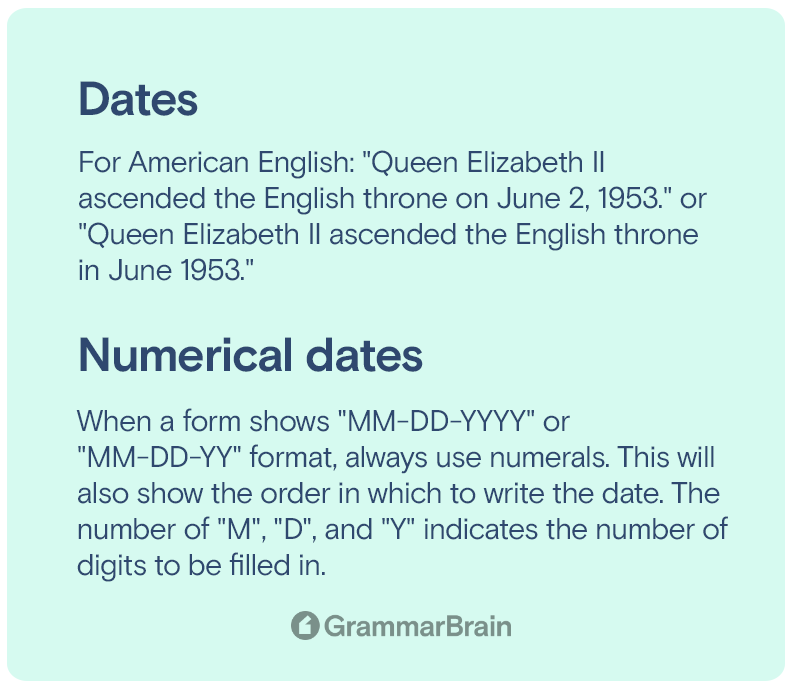
Should “in” or “on” be used when writing dates ?
When referring to an exact day, write the date using “on.” When referring to the year or the month, use “in.”
I am flying to New York on September 10, 2022.
The cafe will cease operations in September 2022.
How are dates written in technical or official documents?
When writing technical or official documents, always follow international standards rather than American or British English. This will make the document understandable to people belonging to different countries.
- Grammarly – How to Write Dates Correctly in English
- Cambridge dictionary – Dates
- The Editor’s Manual – Dates: How to Write Correctly
- LanguageTool – How to Write the Date
Inside this article
Fact checked: Content is rigorously reviewed by a team of qualified and experienced fact checkers. Fact checkers review articles for factual accuracy, relevance, and timeliness. Learn more.

About the author
Dalia Y.: Dalia is an English Major and linguistics expert with an additional degree in Psychology. Dalia has featured articles on Forbes, Inc, Fast Company, Grammarly, and many more. She covers English, ESL, and all things grammar on GrammarBrain.
Core lessons
- Abstract Noun
- Accusative Case
- Active Sentence
- Alliteration
- Adjective Clause
- Adjective Phrase
- Adverbial Clause
- Appositive Phrase
- Body Paragraph
- Compound Adjective
- Complex Sentence
- Compound Words
- Compound Predicate
- Common Noun
- Comparative Adjective
- Comparative and Superlative
- Compound Noun
- Compound Subject
- Compound Sentence
- Copular Verb
- Collective Noun
- Colloquialism
- Conciseness
- Conditional
- Concrete Noun
- Conjunction
- Conjugation
- Conditional Sentence
- Comma Splice
- Correlative Conjunction
- Coordinating Conjunction
- Coordinate Adjective
- Cumulative Adjective
- Dative Case
- Declarative Statement
- Direct Object Pronoun
- Direct Object
- Dangling Modifier
- Demonstrative Pronoun
- Demonstrative Adjective
- Direct Characterization
- Definite Article
- Doublespeak
- Equivocation Fallacy
- Future Perfect Progressive
- Future Simple
- Future Perfect Continuous
- Future Perfect
- First Conditional
- Gerund Phrase
- Genitive Case
- Helping Verb
- Irregular Adjective
- Irregular Verb
- Imperative Sentence
- Indefinite Article
- Intransitive Verb
- Introductory Phrase
- Indefinite Pronoun
- Indirect Characterization
- Interrogative Sentence
- Intensive Pronoun
- Inanimate Object
- Indefinite Tense
- Infinitive Phrase
- Interjection
- Intensifier
- Indicative Mood
- Juxtaposition
- Linking Verb
- Misplaced Modifier
- Nominative Case
- Noun Adjective
- Object Pronoun
- Object Complement
- Order of Adjectives
- Parallelism
- Prepositional Phrase
- Past Simple Tense
- Past Continuous Tense
- Past Perfect Tense
- Past Progressive Tense
- Present Simple Tense
- Present Perfect Tense
- Personal Pronoun
- Personification
- Persuasive Writing
- Parallel Structure
- Phrasal Verb
- Predicate Adjective
- Predicate Nominative
- Phonetic Language
- Plural Noun
- Punctuation
- Punctuation Marks
- Preposition
- Preposition of Place
- Parts of Speech
- Possessive Adjective
- Possessive Determiner
- Possessive Case
- Possessive Noun
- Proper Adjective
- Proper Noun
- Present Participle
- Quotation Marks
- Relative Pronoun
- Reflexive Pronoun
- Reciprocal Pronoun
- Subordinating Conjunction
- Simple Future Tense
- Stative Verb
- Subjunctive
- Subject Complement
- Subject of a Sentence
- Sentence Variety
- Second Conditional
- Superlative Adjective
- Slash Symbol
- Topic Sentence
- Types of Nouns
- Types of Sentences
- Uncountable Noun
- Vowels and Consonants
Popular lessons

Stay awhile. Your weekly dose of grammar and English fun.

The world's best online resource for learning English. Understand words, phrases, slang terms, and all other variations of the English language.
- Abbreviations
- Editorial Policy
- Link to facebook
- Link to linkedin
- Link to twitter
- Link to youtube
- Writing Tips
How to Write Dates Correctly

- 3-minute read
- 23rd October 2014
There are many different ways to write dates, so knowing which one to use in your work can be difficult. At a basic level, you need to get the format and information correct. But you also need to consider whether the style in which you’ve written the date is appropriate for your document.
Read on, then, for our guide on how to write dates correctly.
Writing Out the Date
In very formal writing, it’s often best to write out the date in full. The most formal version of this may include using an ordinal signifier (‘th’, ‘rd’ or ‘st’) after the date, like this:
The meeting is on the 23 rd of October 2016.
However, in most cases, you can just give a date, month and year:
The meeting is on 23 October 2016.
You would still pronounce this as ‘the 23 rd of October’ in speech, but in writing you can simplify this to make it easier to read.
Moreover, in some situations, you may want to include the day of the week in the date, especially if it has specific connotations (e.g. Friday the 13 th ).
Shorter Form Dates
In less formal writing, a shorter date format can be used. This typically uses only numbers separated by full stops or slashes, with no need to write out the name of the month. Shortening the year is also acceptable as long as it will be clear which year you mean, such as in the following:
You can also write out the date but shorten the month to save space:
- 14 January 2016 → 14 Jan 2016
- 9 October → 9 Oct
Although these options are easy to understand and perfectly acceptable in most writing, they are not typically correct in an academic context.
Find this useful?
Subscribe to our newsletter and get writing tips from our editors straight to your inbox.
Australian vs. American Dates
Another thing to keep in mind is that the date format is different in different places. In Australia , we use a day, month, year format, as shown above.
In America, the month comes first. As such, we can reformat some of the examples above to compare how they’d appear in Australia and America:
As you can see above, we’ve used a comma in the US dates to separate the day and the year, both of which are numbers.
The fact that the day and month are swapped around can lead to confusion, especially if written in number form, so do be aware of this!
The International Date Format
Finally, if you’re sharing information across the world, you may want to use the international date format (ISO 8601) . This is a standardised format that works across borders, so it is commonly used by government organizations and global businesses. And it always uses the format YYYY-MM-DD, which removes any chance of confusion:
We sent the invoice on 2020-07-10 .
The date above, for example, denotes the 10th of July 2020.
How to Write the Date in Academic Writing
There is no single ‘correct’ way to write the date in an essay, but it’s usually better to use a formal approach. Check your university style guide and see what it recommends. If it doesn’t specify a format, pick one you feel is appropriate and use it consistently throughout your document.
If you would like to have a 500-word sample of your work proofread for free, get in touch with the professionals at Proofed today!
Share this article:
Post A New Comment
Get help from a language expert. Try our proofreading services for free.
5-minute read
Free Email Newsletter Template (2024)
Promoting a brand means sharing valuable insights to connect more deeply with your audience, and...
6-minute read
How to Write a Nonprofit Grant Proposal
If you’re seeking funding to support your charitable endeavors as a nonprofit organization, you’ll need...
9-minute read
How to Use Infographics to Boost Your Presentation
Is your content getting noticed? Capturing and maintaining an audience’s attention is a challenge when...
8-minute read
Why Interactive PDFs Are Better for Engagement
Are you looking to enhance engagement and captivate your audience through your professional documents? Interactive...
7-minute read
Seven Key Strategies for Voice Search Optimization
Voice search optimization is rapidly shaping the digital landscape, requiring content professionals to adapt their...
How to Ace Slack Messaging for Contractors and Freelancers
Effective professional communication is an important skill for contractors and freelancers navigating remote work environments....

Make sure your writing is the best it can be with our expert English proofreading and editing.
- Grammar Checker
- Paraphrasing Tool
- Critique Report
- Writing Reports
- Learn Blog Grammar Guide Community Events FAQ
- Grammar Guide
How to Write the Date Correctly

By Krystal N. Craiker
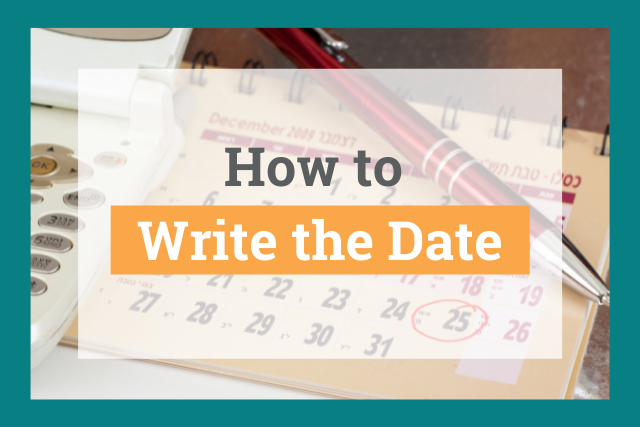
Writing dates can be confusing. Where do the commas go? What if you need to include the day of the week?
Today, we’re teaching you how to write the date correctly every time.
Most of this article will focus on the American date format, but we will cover the differences between British and American English date formats, too.
How to Write Dates
Correct date format in british english, how to write the date and time in a sentence, write dates consistently.
One reason writing dates is so confusing is that there are so many options.
How to write the date varies based on geography, the circumstance, such as how formal you need to be, whether you need the year, and whether you’re using purely numerical forms.
We’ve broken down the different date formats, so you know how to write the date in every situation.
Month-Day-Year
The month-day-year date is the most common format used in America.
When you need to write the entire date, place a comma after the day. Here’s what it looks like:
- July 4, 1776
When we see the date, we read the day in our heads, or out loud, as ordinal numbers. However, it’s not necessary to actually use ordinal numbers (e.g. 4th) when you write the day.
When you write the month-day-year format in the middle of a sentence, place another comma after the year.
- America was founded on July 4, 1776, when the Founding Fathers signed the Declaration of Independence.

Writing just the month and day is simple. Just leave off the comma and the year.
When you write the month-day format in the middle of a sentence, only place a comma after the day if the date ends a dependent clause or introductory phrase. Never place a comma after the month.
- We go every July 4 to see fireworks.
- Because it’s July 4, we are going to see fireworks.
Just like when you include the year, there’s no need to write the ordinal number form of the day.
The only time the date should include an ordinal number is when the format is inverted and the word “of” is included. Here’s an example from a famous folk song:
- I’m a Yankee Doodle Dandy! Yankee Doodle do-or-die. A real live nephew of my Uncle Sam, born on the 4th of July.
In this form, you can use numeric or word formats for the ordinal numbers: 4th or fourth.
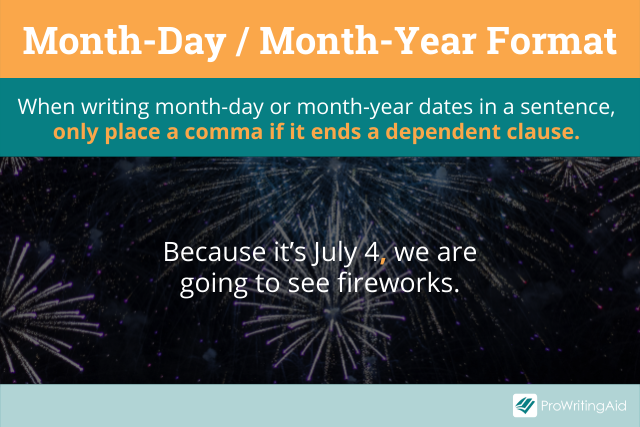
Sometimes, we only need to write dates with the month and year. We might refer to a general time frame, or we may not know the exact date of something.
As with other date formats, don’t include a comma between the month and year. Only place a comma after the year if the date ends a dependent clause or introductory phrase.
Let’s look at a few examples of how to write the month and year.
- Her baby is due in June 2022.
- In June 2022, she will have her baby.
With the Day of the Week
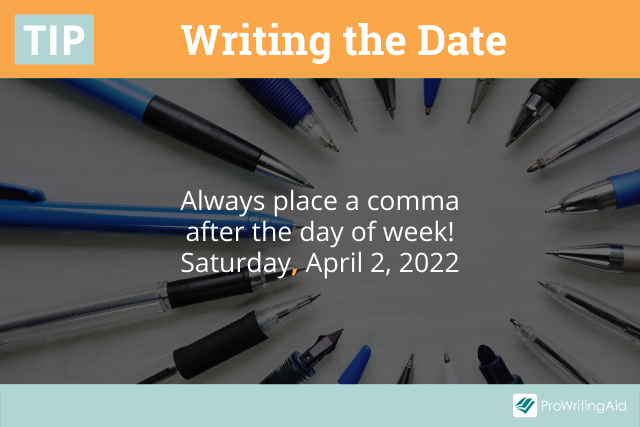
When writing dates with the day of the week, always place a comma between the day of the week and the rest of the date. Then, follow the above rules for the rest of the date.
This is one type of date format where the comma rule is the same for British English: you always put a comma after the day of the week.
Here are some examples of how to write the date with the day of the week. Please note these examples are using the American date format.
- Saturday, April 2, 2022
- The wedding is Saturday, April 2, 2022.
- The wedding takes place Saturday, April 2, 2022, at the Bellagio Chapel in Vegas.
Numerical Forms
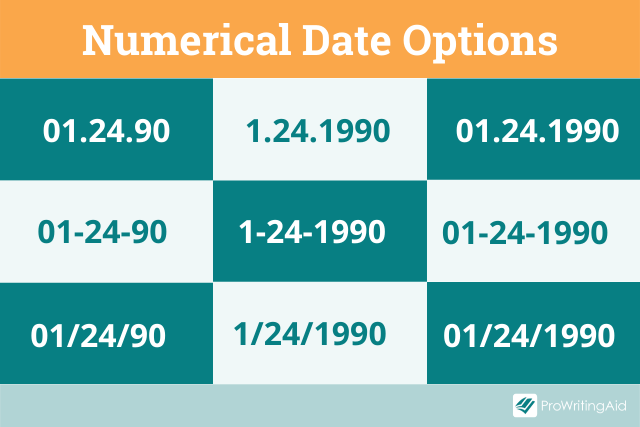
We don’t always write dates by spelling out the month. Often, we use an all-numeric date format, such as when we sign a form, take notes, or write in a diary.
Typically, we don’t use the purely numerical form when writing the date in a sentence. In those situations, use the rules above and spell out the month.
When you do write the date with just numbers, there are a few ways you can format it. However, you should always use the month-day-year format for American English.
There are a few accepted punctuation marks for numeric dates: hyphens , slashes , and periods . In American dates, hyphens and slashes are the most common.
It’s also acceptable to omit the zero in the month or day, if the number is less than 10. However, some online forms will require you to use a zero.
You can use either four digits or two digits for the year. Only use two-digit numbers if it’s clear which century you’re talking about.
If it’s a birthdate of a living person, we can deduce whether the year occurred in the 1900s or 2000s.
Now, let’s take a look at several ways we might write the same date in the numerical format.
Selecting one of these date formats is usually a matter of personal preference, although if you have a style guide for your writing, defer to its formatting.
The important thing is to be consistent with whichever format you choose.
Years, Decades, and Centuries
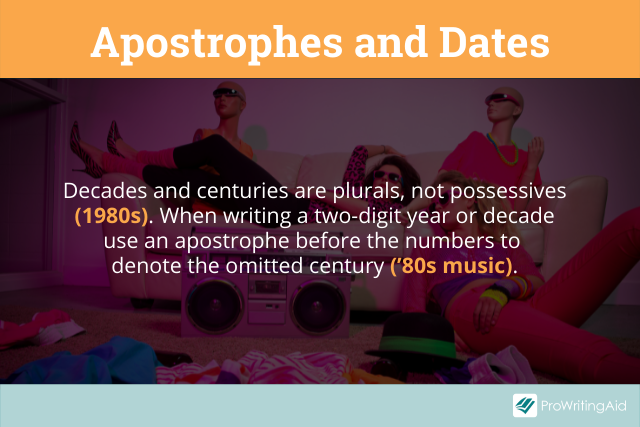
Years, decades, and centuries can be confusing to write. Let’s look at each type in more detail.
When we write the year, we typically use a four-digit format.
We saw in the previous section that we can use a two-digit year in the numeric form. Both four digits and two digits are correct and are a matter of personal preference.
But sometimes we reference a year in a sentence and only use two-digits. In this case, we place an apostrophe before the digits. The apostrophe replaces the century of a four-digit year.
- I bought a ’69 Camaro.
We don’t always use a two-digit format in a sentence. You could say, “I bought a 1969 Camaro.” But when you choose to use only two-digits in a sentence, the apostrophe is required.
Remember, the apostrophe is not required when you write an entire, exact date in numerical form.
When we write years out in long form, you can include “and” after “thousand,” or you can omit it. American English tends to omit the “and,” but it's correct either way.
- Correct: Two thousand eight was when I graduated high school.
- Correct: Two thousand and eight was when I graduated high school.
Apostrophe rules get tricky when we write decades. When we reference a decade, the rules for writing plurals apply: never use apostrophes for plural words. For decades, never put an apostrophe between the decade and the /s/.
- Incorrect: I love listening to the hair bands of the 1980’s.
- Correct: I love listening to the hair bands of the 1980s.
If you omit the first two digits, place an apostrophe before the decade number. You still shouldn’t put an apostrophe before the /s/.
- Incorrect: I love listening to the hair bands of the 80’s.
- Incorrect: I love listening to the hair bands of the ’80’s.
- Correct: I love listening to the hair bands of the ’80s.
You can also write the decade in word form, e.g. “eighties.”
Similarly to decades, if you reference a century in a four-digit format, do not place an apostrophe before the /s/.
- Incorrect: I love the fashion of 1700’s.
- Correct: I love the fashion of the 1700s.
Adding an apostrophe to plurals is a common writing error. ProWritingAid will point out unnecessary apostrophes in your plural numbers.
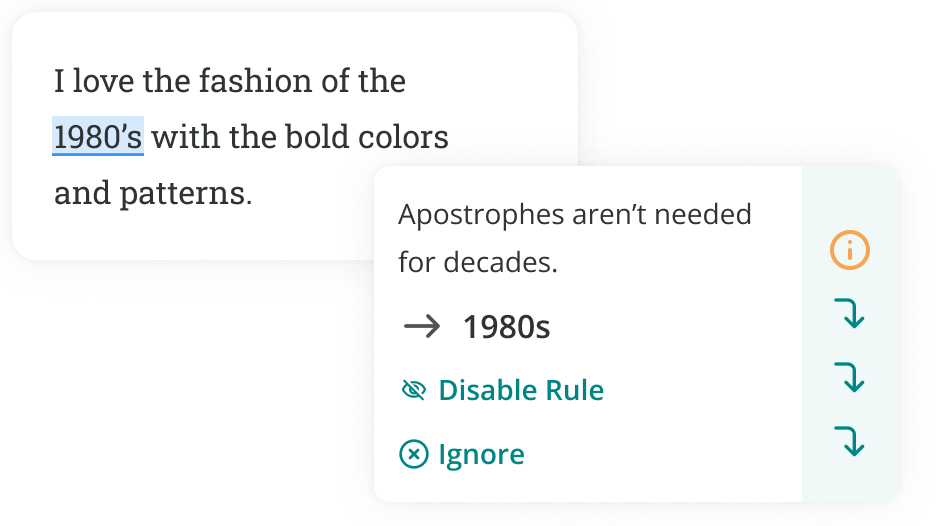
When you write centuries in the ordinal form, add the correct suffix after the number or use the word format. There’s no need to capitalize the word form.
- Correct: I love 18th-century fashion.
- Correct: I love eighteenth-century fashion.

British English uses a different date format in which the month and day are inverted (day-month-year). In British English, dates do not need commas before or after the year, even in a sentence.
- 11 November 1918
- Armistice Day on 11 November 1918 marked the end of World War I.
The inverted format also applies to numeric dates, e.g. 14/2/2017.
We’ve seen several examples of how to write the date in a sentence. Writing the time in a sentence is simple.
You can write the time in a sentence as hour:minute plus a.m. or p.m. If you’re using a 24-hour time format, the a.m. or p.m. is not required.
You can also leave it off if it’s clear what time of day something occurs. Here’s what this looks like:
- I get out of school at 3:45 p.m.
- I get out of school at 3:45. (The p.m. is not necessary because we can assume you don’t get out of school at 3:45 a.m.)
- I get out of school at 15:45.
If the time that you’re writing occurs on the hour, you can also write “o’clock.” Instead of a.m. or p.m., describe the time of day if necessary.
- He will be there at four o’clock.
- He will be there at four o’clock in the afternoon.
If you need to write both the time and date, just combine the rules. Here are two examples:
- My flight arrives on December 13 at 10:40 a.m.
- Your appointment is at 2 o’clock on February 27, 2022.
There are many ways to write a date, but it’s important to use the same format consistently throughout your writing.
ProWritingAid’s Consistency Report can check for consistent mechanics, like dates, punctuation, spelling variations, and more.
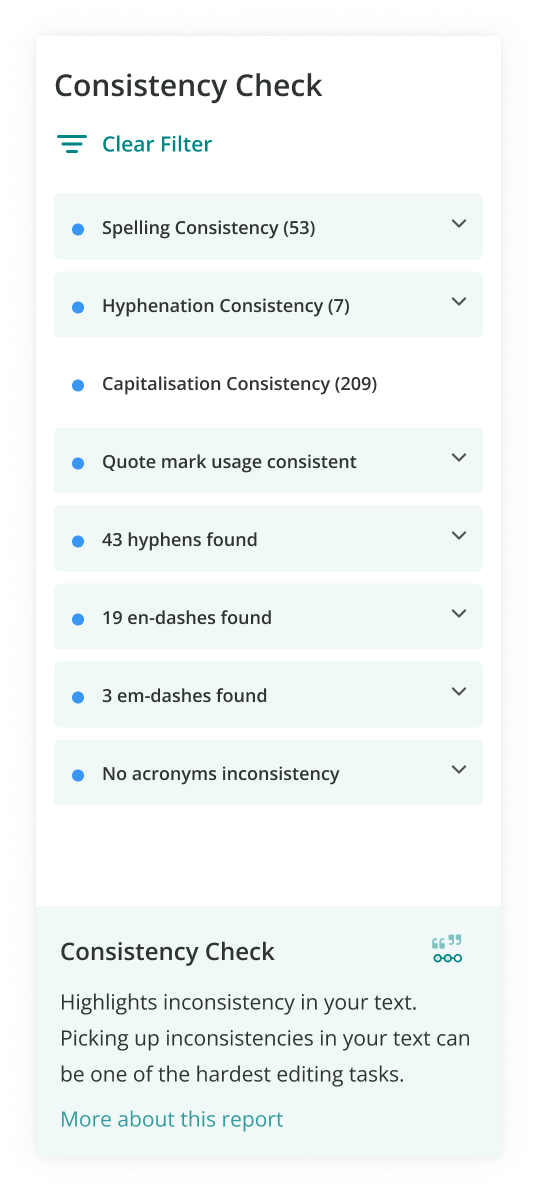
Take your writing to the next level:

20 Editing Tips from Professional Writers
Whether you are writing a novel, essay, article, or email, good writing is an essential part of communicating your ideas., this guide contains the 20 most important writing tips and techniques from a wide range of professional writers..

Be confident about grammar
Check every email, essay, or story for grammar mistakes. Fix them before you press send.
Krystal N. Craiker
Krystal N. Craiker is the Writing Pirate, an indie romance author and blog manager at ProWritingAid. She sails the seven internet seas, breaking tropes and bending genres. She has a background in anthropology and education, which brings fresh perspectives to her romance novels. When she’s not daydreaming about her next book or article, you can find her cooking gourmet gluten-free cuisine, laughing at memes, and playing board games. Krystal lives in Dallas, Texas with her husband, child, and basset hound.
Get started with ProWritingAid
Drop us a line or let's stay in touch via :
The Editor’s Manual
Free learning resource on English grammar, punctuation, usage, and style.
How to Write Dates

To write the exact date, spell out the month, and write the day and the year in numerals. The American date format is month-day-year, with a comma between day and year ( May 1, 2022) , while the British format is day-month-year, with no comma between month and year ( 1 May 2022 ). Don’t use ordinal numbers in dates in formal texts ( May 1 st , 2022 ). You may also show the day of the week ( Sunday, May 1, 2022 ).
If only the month and year are shown, don’t insert a comma between the two ( May 2022 ). To specify the day alone, write it as an ordinal number ( We arrive on the first ).
![how to properly write a date in an essay Graphic titled "How to Write Dates." The left panel shows an illustration of two people marking the date on a gigantic calendar. The right panel lists the following rules and examples. Spell out the month. Use numerals for day and year (“American: December 16, 2021”; “British: 16 December 2021”). Don’t place a comma between month and year (“Poor: We met in December, 2021”; “Better: We met in December 2021”). Write the day as an ordinal when it stands alone (“They left on the sixteenth [or 16th]”).](https://editorsmanual.com/wp-content/uploads/2022/11/dates-2-media-1024x576.webp)
Date: Month, day, and year
The American date format is month-day-year. In running text, spell out the month, and write the day and year in numerals. Use commas to separate day and year. Don’t use ordinals ( st , nd , rd , th ).
- The Declaration of Independence was issued on July 4, 1776 .
- They were married on October 25, 2019, on a beach in the Maldives.
- On January 20, 2021, Joe Biden became president of the United States.
To set off the year, use commas in pairs: a comma must appear not just before but also after the year.
- Incorrect: It was on August 14, 1945 that an armistice was finally declared. Correct: It was on August 14, 1945, that an armistice was finally declared.
The British date format is day-month-year. The day and year are written in numerals, and the month is spelled out. No comma is needed between month and year. This system is also followed in much of Europe and the rest of the world.
- On 15 August 1947 , India gained independence from Britain.
- The Channel Tunnel opened on 6 May 1992 , linking London and Paris by rail.
- The UK left the EU on 31 January 2020 .
Date: Month and year
When only month and year are specified, the month appears before the year. No comma is needed between the two.
- Twitter was founded in March 2006 and launched later that year.
- In January 2020 , reports of a new respiratory virus emerged from China.
- Farley first lost the lottery in November 1997 .
The preposition “of” between month and year is unnecessary and omitted in formal writing.
- This report was originally published in May of 2015 .
Date: Day and month
When it is clear which year is being referred to, you may indicate only day and month. Spell out the month, and write the day in numerals. Remember that day follows month in American usage. Don’t use ordinal numbers ( st , nd , rd , th ).
- Her birthday is November 23 .
- The last day to submit your applications is February 10 .
- On May 11 this year, our astronauts landed on Venus.
In British and other European writing, the day appears before the month.
- My daughter was born on 23 November last year.
- The deadline is 10 February .
- On 11 May this year, our astronauts landed on Mars.
The use of ordinal numbers ( st , nd , rd , th ) in dates is unnecessary. Avoid it in formal writing.
- Poor: The Durandians landed on July 19th at 3 p.m. Better: The Durandians landed on July 19 at 3 p.m.
In creative and other informal writing, the day and the month are often shown in words.
- They were married on the nineteenth of September last year.
Date: The day alone
When only the day is mentioned, spell out single-digit numbers. Two-digit days may be either spelled out or written in numerals. Use ordinal numbers ( st , nd , rd , th ).
- We woke up early on the morning of the fifth .
- We’ll reach on the sixteenth ( or the 16th ).
Style guides differ in their recommendations on whether to write numbers in numerals or words. Numbers under 10 are generally spelled out. The Chicago Manual of Style recommends spelling out two-digit numbers as well, while the AP Stylebook and APA Publication Manual suggest using figures for numbers from 10 onward.
When using figures, don’t set the ordinal in superscript (16th, not 16 th ).
Date with day of the week
To show a day of the week alongside a date, write the day followed by a comma, and then write the date. This can be helpful in appointments and invitations.
- American: The apocalypse was expected to happen on Saturday, May 21, 2011 .
- British: The conference starts on Monday, 8 August 2022 .
The date in numerals
Dates may be written in all numerals . A numeric date format is used when the date is standalone—for example, in a signature. The U.S. date format is month-day-year, while the day-month-year format is followed by the UK and other nations. Slashes or hyphens are used to separate the parts of the date.
- American : Signed 5-11-21 for May 11, 2021 British: Signed 11-5-21 for 11 May 2021
- American: Dated 11/5/2021 for November 5, 2021 British: Dated 5/11/2021 for 5 November 2021
All-numeric dates are also written in the YYYY-MM-DD format, as specified by the ISO . This internationally agreed way to show dates is common in government, corporate, and other official usage. One of the benefits of this system is that it makes for easier sorting and storage of files and folders. In file names and data entries, hyphens are generally omitted.
- Please submit all applications by 2023-05-01 . referring to May 1, 2023
- Application_ 20230501 date in a file name
The date in words
Dates are generally written in words rather than numerals in creative writing and legal documents. Spell out the day and the month, but use numerals for the year.
- Where were you on the night of the fifteenth at 11 p.m.?
- On the twenty-second of January 2021 , an object landed in Farley’s garden.
- They left on the first of December .
In formal writing, follow the prescribed format of writing the day and year in figures and spelling out the month.
- American: On January 22, 2021, an object landed in Farley’s garden. British: On 22 January 2021 , an object landed in Farley’s garden.
- American: They left on December 1 . British: They left on 1 December .
The month abbreviated
When part of a specific date, the month may be abbreviated . Write the first three letters of the month, followed by a period . Don’t abbreviate May, June, and July. In formal writing, abbreviations for dates are useful in tables and charts but avoided in running text.
- Jan. 9, 1997
- Feb. 24, 2022
- May 1, 1997
In British style, the form is day-month-year.
- 9 Jan. 1997
- 24 Feb. 2022
In AP style, the abbreviations Jan. , Feb. , Aug. , Sept. , Oct. , Nov. , and Dec. are used. The remaining months are not abbreviated.
Periods may be omitted in informal usage, if there are space constraints, or in a fixed format, such as a table. The months June and July are also then abbreviated.
- Jan 9, 2021
- Jun 11, 2023
- 11-Jun-2023
- 29 Dec 2051
On vs. in with dates
Use on with a date with the exact day. Use in to refer to the month or the year.
- Your flight departs on August 3, 2022 .
- Your flight departs on the third of August .
- The restaurant will reopen in August 2022 .
- The restaurant will reopen in August .
- The restaurant will reopen in 2022 .
Share this article
Place a comma between the day and the year in a date.
No comma is necessary between the month and the year in a date.
No comma is needed between the month and the year in a date.
Ordinals are not used in dates in formal writing.
- AI in action
- AI in the enterprise
- Humans of AI
Words at work
- Inside Writer
- Content strategy
- Inspiration
– 5 min read
How to write dates perfectly

Jessica Malnik
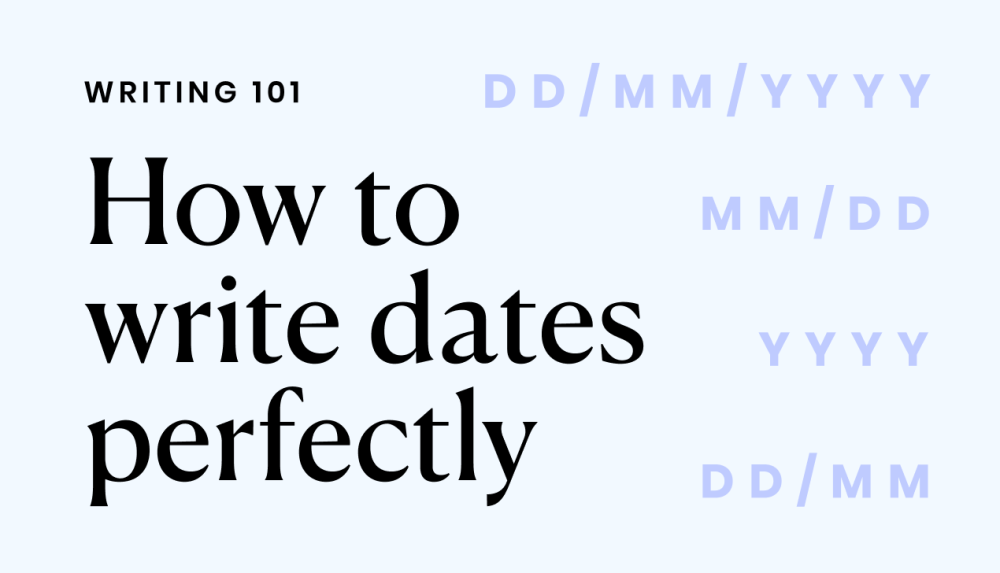
Writing dates can feel stressful because the rules and guidelines vary not just between US English or British English, but also depending on your preferred style guide .
In this post, we share general guidelines to help you write dates perfectly every time.
Note: Before we dive in, we’ll focus on how to write dates in US English.
How to write dates in US English correctly
As a general guide, dates are typically written in the order of month – day – year in US English. Here are the general rules and examples when using dates in your writing.
How to write the year
The year is typically written as numerals in US English. An exception is if you start your sentence with the year. In that situation, you should write out the year in words.
Note: When writing the year in words, you generally don’t write and after thousand when discussing a year after 2000 in US English.
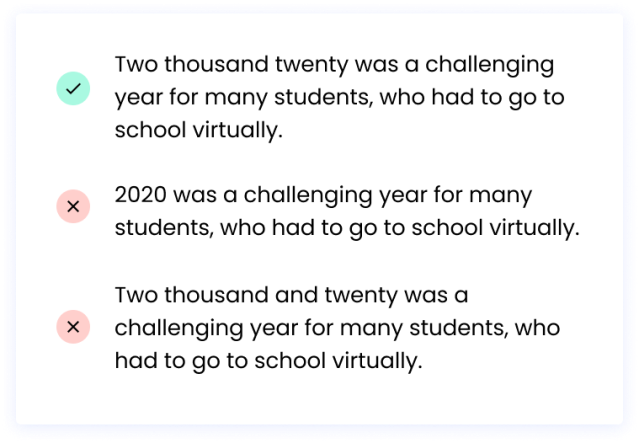
How to write months and days
There are different formats you can select when writing the months and days, depending on your needs. When writing the month and day, you put the month before the date and use cardinal numbers (1, 2, 3, 4…) instead of ordinal numbers (1st, 2nd, 3rd, 4th…).
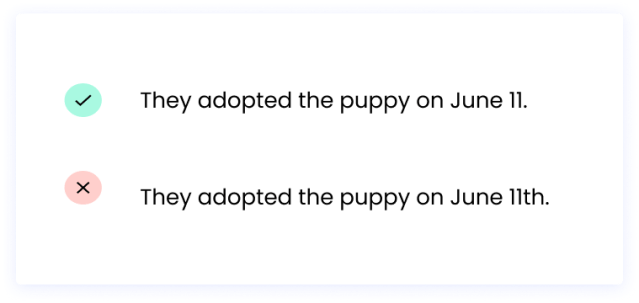
If you want to write the date using the month, day, and year, you’ll use cardinal numbers for the day. You’ll also need a comma between the day and year. In US English, the month comes before the day, and the year comes after the day.
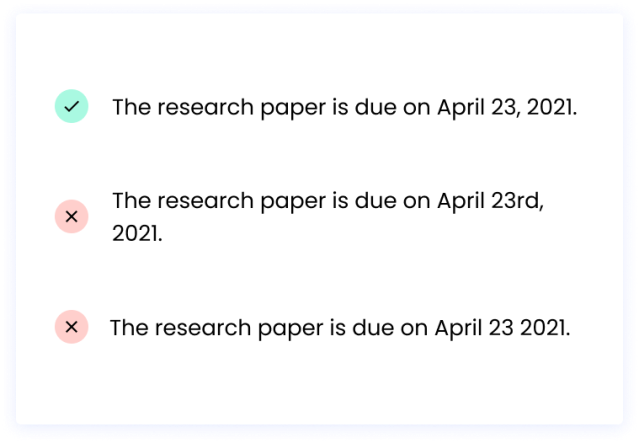
You can use ordinal numbers if you’re writing the date using of or writing the day without including the month.
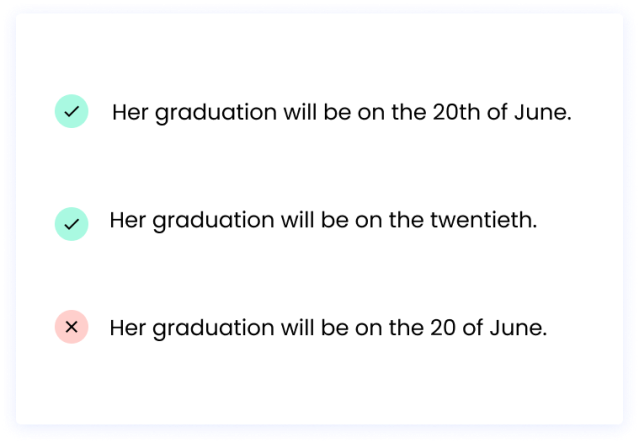
How to write dates with days of the week
You’ll write the day of the week before the rest of the date when you want to include the day of the week. You’ll need to place a comma after the day of the week to separate it from the rest of the date.
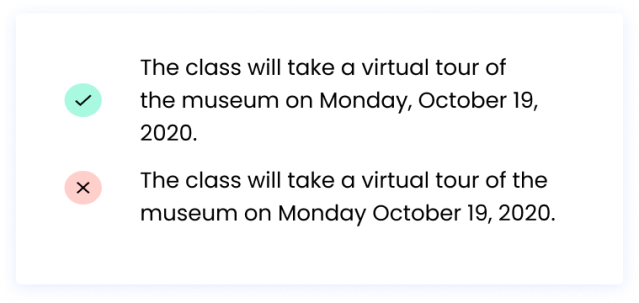
How to write dates as decades and centuries
When writing the date as a decade or century, you can write it numerically or in words.
When writing decades numerically, you can write them as two-digit numbers with an apostrophe before the numbers and an “-s” after the numbers. You do this because when the decade is in a two-digit form, it’s both an abbreviation and plural.
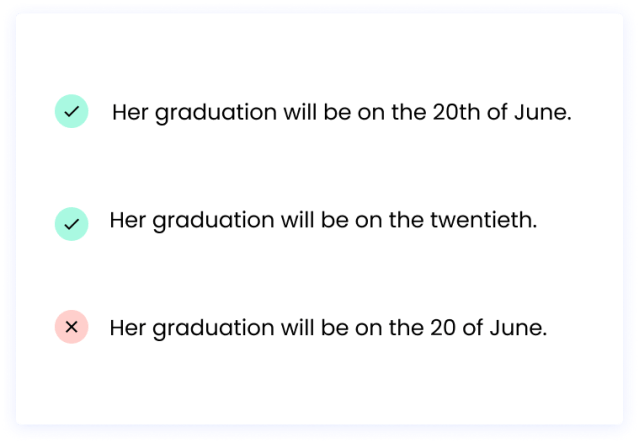
The decade can also be written as four-digit numbers with an “-s” after the numbers, like this: 1990s. However, if you don’t include the “-s,” the reader may think you’re referring to that year instead of the whole decade.
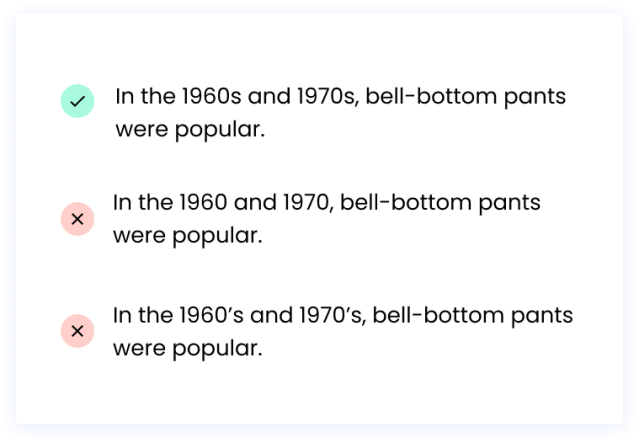
When writing centuries numerically, you don’t use an apostrophe before the “-s” since centuries are plural and not possessive.
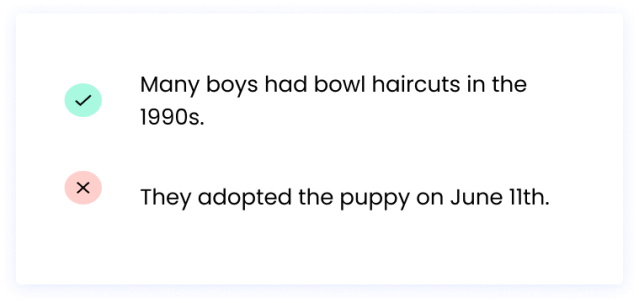
As with decades, you can also write out the century in words, such as the nineteenth century . Centuries are typically lowercase, unless it starts the sentence or is used in a title.
How to write dates in essays and papers
When writing dates in essays and papers, you want to follow the rules indicated by the style guide you’re asked to follow, such as AP Stylebook , Chicago Manual of Style, The Cambridge Guide to English Usage, etc.
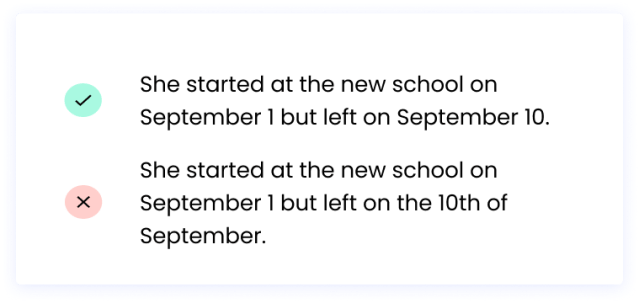
If you’re writing a formal paper, you’ll typically want to avoid abbreviations. If you choose to abbreviate part of the date, make sure the reader can understand the date based on the context clues. For instance, if you abbreviate the decade as the ’40s, it should be clear whether you mean the 1940s, the 1840s, and so on.
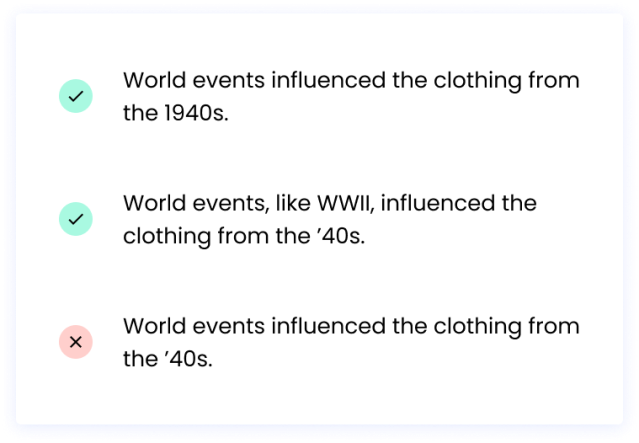
How to write dates in British English
When writing dates in British English, a lot of the rules are the same. However, there are a few key differences, including:
- Dates are typically written in the order of day – month – year in British English.
- When you’re writing the year in words, in British English, you write and after thousand when discussing a year after 2000.
- If you’re adding the day of the week to the date, it comes before the date. You should separate the name of the day from the date by using a comma or by using the and of .
While there are different rules and styles to writing dates, the process doesn’t have to be difficult. To help guide you, determine your primary audience, whether you need to follow a particular style guide, and write the dates consistently throughout. When writing, you’ll also want to make sure that any abbreviations make sense within the context of your paper. If there could be any confusion, you’ll want to avoid using abbreviations.
Concerned about writing dates incorrectly? Try Writer! Start a free trial and set your preferred format for short dates, long dates, and more.
--> “A wide screen just makes a bad film twice as bad.” -->
May Habib CEO, Writer.com
Here’s what else you should know about Ascending.
More resources
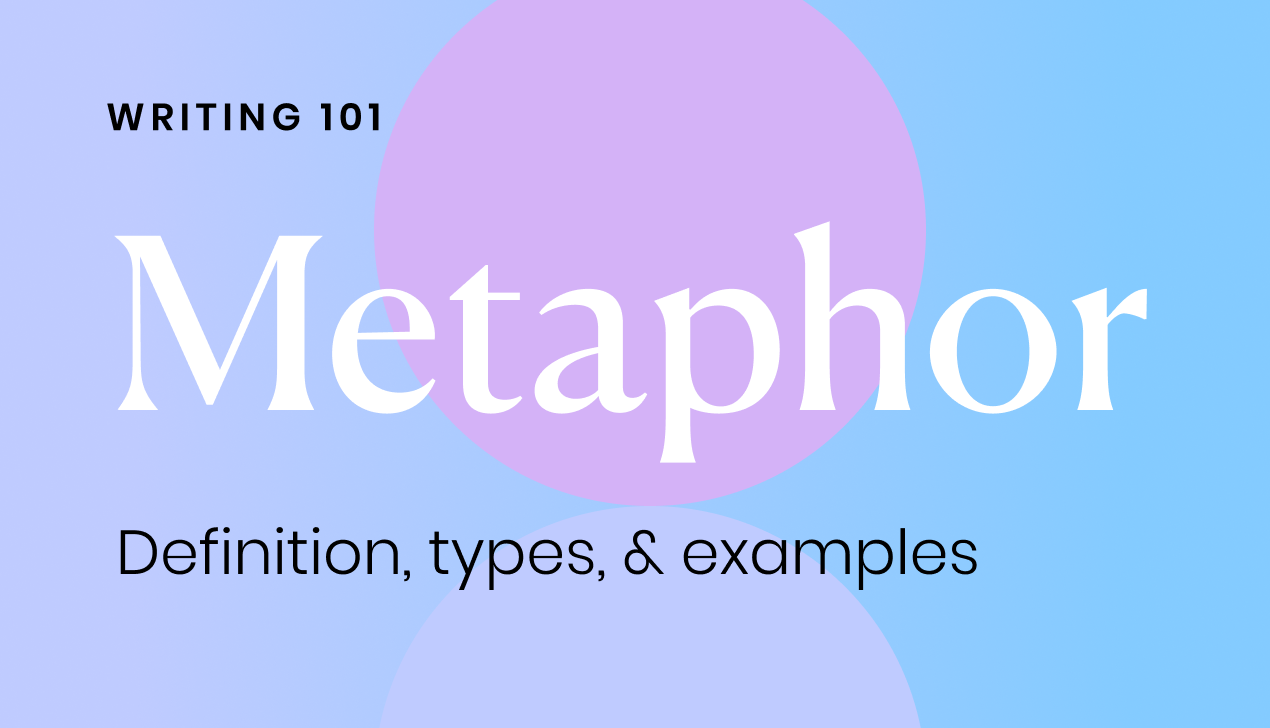
– 10 min read
Metaphor: definition, types, and examples

Masooma Memon

– 11 min read
The best writer tools

Devon Delfino

– 9 min read
How to empower your sales team with persuasive writing skills

Alaura Weaver
Generate accurate MLA citations for free
- Knowledge Base
- Formatting dates in MLA style
MLA Date Format | Dates in the Works Cited & Main Text
Published on July 7, 2021 by Jack Caulfield . Revised on March 5, 2024.
In MLA Works Cited entries, publication dates are presented in day-month-year order. If the name of the month has five or more letters, abbreviate it to the first three.
Sometimes you just list the year (e.g. when citing a book ), but if the source provides a more specific publication date, you should usually include it (e.g. when citing a journal article or web page ). Occasionally you might even list the time of publication in addition to the date (e.g. when citing a timestamped online comment).
- spring 2017
- 5 Mar. 2017
- 5 Mar. 2017, 1:15 p.m.
Don’t use ordinal numbers (e.g. “5th”) or commas within a date in the Works Cited list. Don’t include a 0 before a single-digit date (e.g. “05”), even if your source does.

Instantly correct all language mistakes in your text
Upload your document to correct all your mistakes in minutes

Table of contents
Abbreviating months, levels of detail in mla dates, when to include an access date, date ranges, approximate or uncertain dates, adding the original publication date, formatting dates in the main text, frequently asked questions about mla citations.
All months with names five or more letters long are abbreviated in Works Cited entries. Abbreviate to the first three letters, followed by a period.
Bear in mind that months are not abbreviated in the main text or the header , though—only in the Works Cited list.
| Month | Abbreviation |
|---|---|
| January | Jan. |
| February | Feb. |
| March | Mar. |
| April | Apr. |
| May | May |
| June | June |
| July | July |
| August | Aug. |
| September | Sep. |
| October | Oct. |
| November | Nov. |
| December | Dec. |
Prevent plagiarism. Run a free check.
An MLA Works Cited entry always contains the year of publication, but some source types specify more precise publication dates. For example, journals generally provide a month or season of publication, while newspapers and online articles usually have a specific date. As a general guideline, include the level of detail your source gives.
The level of detail can sometimes vary based on your reasons for citing the source. For example, for an episode of a TV series you’d usually just give the year, but you might give the day and month too if you’re discussing the context in which the episode aired.
The table below indicates the level of detail usually given for each source type. If less detail is available for your source than shown here, just include as much detail as you do have (e.g. just the year for a web page that only lists the year).
| Level of detail | Source types | Example |
|---|---|---|
| Year | Butler, Judith. . 2nd ed., Routledge, 1999. | |
| Month & year | Eve, Martin Paul, and Joe Street. “The Silicon Valley Novel.” , vol. 27, no. 1, May 2018, pp. 81–97, https://doi.org/10.1177/0306197318755680. | |
| Season & year | Britton, Jeanne M. “Novelistic Sympathy in Mary Shelley’s .” , vol. 48, no. 1, spring 2009, pp. 3–22, www.jstor.org/stable/25602177. | |
| Day, month & year | Smith, Helena. “The Women Who Brought Down Greece’s Golden Dawn.” , 22 Oct. 2020, www.theguardian.com/world/2020/oct/22/the-women-who-brought-down-greeces-golden-dawn. | |
| Specific time of day | Caulfield, Jack. Comment on “How to Cite a Book in MLA.” , 22 Apr. 2021, 5:22 p.m., www.scribbr.com/mla/book-citation/. |
For online sources, MLA advises including an access date for
- A source with no publication date listed
- A source that’s continually updated
- A source that may have been deleted since you used it
At the end of the Works Cited entry, write “Accessed” followed by the day, month, and year on which you accessed the source:
But only use access dates with online sources . No access date should be added for, e.g., a printed book without a publication date.
When citing the entirety of a source published over a longer period of time (e.g. a TV series , a book published in several volumes , an event that took place over several days), you’ll have to cite a range of dates rather than just a single date.
Use an en dash (–) with no spaces to specify a range of dates.
Don’t repeat elements that are the same in both dates. For example, if citing a range of dates within one month, don’t repeat the month. In a range consisting only of years, you can omit the first two numbers from the second year if they’re the same as those of the first year.
- 15 Dec. 2019–22 Jan. 2020.
- 19–21 Mar. 2021.
- 27 Apr.–4 May 2018.
If citing a publication that is still ongoing, leave a space after the en dash to indicate this.
Note that date ranges are not needed to cite a single episode in a series, a single volume of a book, or a single issue or article within a journal. They’re only needed when you’re citing the whole longer publication.
Receive feedback on language, structure, and formatting
Professional editors proofread and edit your paper by focusing on:
- Academic style
- Vague sentences
- Style consistency
See an example

Occasionally, you might only have an approximate or uncertain date for a source. This is sometimes the case with older works, and artworks contained in museums , where the exact year of composition is unknown.
Approximate dates
The term “circa” (Latin for “around”) is used for approximate dates, sometimes abbreviated to “c.” Use it in your Works Cited entry when applicable—spelled out, not abbreviated. It may appear with a single year or a range.
Alternatively, a general period such as “late thirteenth century” may be given. Spell out the ordinal number in this case (i.e. “thirteenth,” not “13th”), even if your source doesn’t.
Uncertain dates
Your source may indicate that the date given is uncertain with a question mark or with qualifiers like “possibly 1819” or “probably 1745.”
In these cases, include a question mark after the year in your Works Cited entry. If a period would usually follow the date, omit it, but retain a comma in addition to the question mark if one would usually appear there.
Classic works are often republished in thousands of different editions . The most important publication date to give is that of the edition you used.
But you might decide in some cases that it’s also useful to give the original publication date. For example, if you’re discussing how a particular writer’s work developed over time, it might be useful to give the original publication date for each text in your Works Cited list.
The original publication date should be added directly after the title of the source it refers to, while the publication date of the edition you used appears later in the usual position of the date element.
In the main text, dates are presented differently. The main difference is that you shouldn’t abbreviate the names of months in the main text. This is done in the Works Cited list to save space, but it’s not appropriate elsewhere.
Additionally, dates don’t have to be presented in day-month-year order in the main text. You can use one of two formats: Month Day, Year, or Day Month Year . Choose one or the other and use it consistently.
- Mary Shelley was born on August 30, 1797, and died on February 1, 1851 .
- Mary Shelley was born on 30 August 1797 and died on 1 February 1851 .
Days and years should always be written as numerals . You can refer to decades either with numerals or spelled out . Use one style or the other consistently.
- Blade Runner is one of the most influential films of the 1980s .
- Blade Runner is one of the most influential films of the eighties .
In your MLA Works Cited list , dates are always written in day-month-year order, with the month abbreviated if it’s five or more letters long, e.g. 5 Mar. 2018.
In the main text, you’re free to use either day-month-year or month-day-year order, as long as you use one or the other consistently. Don’t abbreviate months in the main text, and use numerals for dates, e.g. 5 March 2018 or March 5, 2018.
In an MLA Works Cited list , the names of months with five or more letters are abbreviated to the first three letters, followed by a period. For example, abbreviate Feb., Mar., Apr., but not June, July.
In the main text, month names should never be abbreviated.
The level of detail you provide in a publication date in your Works Cited list depends on the type of source and the information available. Generally, follow the lead of the source—if it gives the full date, give the full date; if it gives just the year, so should you.
Books usually list the year, whereas web pages tend to give a full date. For journal articles , give the year, month and year, or season and year, depending on what information is available. Check our citation examples if you’re unsure about a particular source type.
When an online source (e.g. web page , blog post) doesn’t list a publication date , you should instead list an access date .
Unlike a publication date, this appears at the end of your MLA Works Cited entry, after the URL, e.g. “A Complete Guide to MLA Style.” Scribbr , www.scribbr.com/category/mla/. Accessed 28 Mar. 2021 .
For offline sources with no publication date shown, don’t use an access date—just leave out the date.
Cite this Scribbr article
If you want to cite this source, you can copy and paste the citation or click the “Cite this Scribbr article” button to automatically add the citation to our free Citation Generator.
Caulfield, J. (2024, March 05). MLA Date Format | Dates in the Works Cited & Main Text. Scribbr. Retrieved August 12, 2024, from https://www.scribbr.com/mla/dates/
Is this article helpful?

Jack Caulfield
Other students also liked, mla titles: formatting and capitalization rules, author names in mla | citing one or multiple authors, how to format your mla works cited page, get unlimited documents corrected.
✔ Free APA citation check included ✔ Unlimited document corrections ✔ Specialized in correcting academic texts
- PRO Courses Guides New Tech Help Pro Expert Videos About wikiHow Pro Upgrade Sign In
- EDIT Edit this Article
- EXPLORE Tech Help Pro About Us Random Article Quizzes Request a New Article Community Dashboard This Or That Game Happiness Hub Popular Categories Arts and Entertainment Artwork Books Movies Computers and Electronics Computers Phone Skills Technology Hacks Health Men's Health Mental Health Women's Health Relationships Dating Love Relationship Issues Hobbies and Crafts Crafts Drawing Games Education & Communication Communication Skills Personal Development Studying Personal Care and Style Fashion Hair Care Personal Hygiene Youth Personal Care School Stuff Dating All Categories Arts and Entertainment Finance and Business Home and Garden Relationship Quizzes Cars & Other Vehicles Food and Entertaining Personal Care and Style Sports and Fitness Computers and Electronics Health Pets and Animals Travel Education & Communication Hobbies and Crafts Philosophy and Religion Work World Family Life Holidays and Traditions Relationships Youth
- Browse Articles
- Learn Something New
- Quizzes Hot
- Happiness Hub
- This Or That Game
- Train Your Brain
- Explore More
- Support wikiHow
- About wikiHow
- Log in / Sign up
- Education and Communications
- Technical Writing
How to Write Dates
Last Updated: March 29, 2024 Fact Checked
This article was reviewed by Tami Claytor . Tami Claytor is an Etiquette Coach, Image Consultant, and the Owner of Always Appropriate Image and Etiquette Consulting in New York, New York. With over 20 years of experience, Tami specializes in teaching etiquette classes to individuals, students, companies, and community organizations. Tami has spent decades studying cultures through her extensive travels across five continents and has created cultural diversity workshops to promote social justice and cross-cultural awareness. She holds a BA in Economics with a concentration in International Relations from Clark University. Tami studied at the Ophelia DeVore School of Charm and the Fashion Institute of Technology, where she earned her Image Consultant Certification. There are 8 references cited in this article, which can be found at the bottom of the page. This article has been fact-checked, ensuring the accuracy of any cited facts and confirming the authority of its sources. This article has been viewed 637,361 times.
Writing out the date can seem simple and oddly complicated at the same time. You only have a few pieces of information to convey, but there’s no one way to write the date. Instead, there are a handful of formatting varieties for different occasions, dialects, and purposes. When choosing a date format, use the one that will provide the most clarity to your audience. If you’re entering dates into a form, stick with a numerical format that can’t be confused. If you’re writing to an international recipient, consider spelling out the month or following the International Standard. In terms of formality, you can show respect on a formal document by writing out the entire date, but feel free to keep the date on an informal letter short and sweet.
Following Dialectical Standards

- October 9, 2022
- October ninth, 2022
- Sunday, October 9, 2022
- Placing a comma between the month and year in British English is optional.

- 9th October
- 9 October 2022
- Sunday the 9th of October 2022

- The 9th of October
- Sunday the ninth of October

- The 21st of June
- The 22nd of July
- The 23rd of August
- The 24th of September
- Note that numerals in the teens are followed by -th. So you’d write 11th, 12th, and 13th instead of 21st, 22nd, and 23rd.
- This tactic is less commonly used in American English but is still accepted.

- The same date, which would be 10/09/22 in American English but 09/10/22 in British English becomes 2022-10-09 in the International Standard.
- You could also write this date out as 2022 October 9. Don’t use commas between any of the data points.
- Always include the full 4-digit year when using this format.
Using Different Levels of Formality and Scope

- For an invitation, try “We request your presence on the fifth of April in the year two thousand and twenty.”
- Use this format to express courtesy and deference to the reader and the occasion.

- When identifying an event or occasion, write “on” before a day. If you omit the day, insert “in” before the month or year.
- In British English, you could write “she was born on 8 May 1883” or “she was born on the 8th of May 1883.”
- In American English, try “she was born on May 8, 1883” or “she was born in May 1883.”

- You can include the date in MM/DD/YY format at the top of a greeting card so your recipient knows when it was written.
- A museum database may use the YYYY-MM-DD format to identify when an object was acquired.
- You may be asked to provide your date of birth in MM-DD-YYYY format on a government form.
Formatting Numerical Dates

- Stick with hyphens for the International Standard. The same date would be written as 2003-23-11 in this format. [11] X Research source

- For instance, you could use either 3/2/15 or 03/02/15.
- In a list of dates, 03/02/15 would be the same length as 12/02/15.
- If you use 3/2/15 in your list, the earlier date may incorrectly be sorted after the later date. This happens because the first digit in the March date (3) is larger than the first digit in the December date (1). Add a “0” to prevent this error.

- Use a “0” before single-digit days and months as needed.
- If you’re asked to provide the date as MM/DD/YY you could write 05/12/94.
- If you’re asked for DD-MM-YYYY, this date would be 12-05-1994.
- You may see these letters without any separation on some forms. For DDMMYY, simply enter 120594 unless otherwise noted.
Expert Q&A
- When writing the date, tailor your formatting to your audience. If you’re writing for an international audience, use a format that cannot be confused, such as the International Standard or one with the month spelled out. Thanks Helpful 2 Not Helpful 1

You Might Also Like

- ↑ https://iso.mit.edu/americanisms/date-format-in-the-united-states/
- ↑ https://www.grammarly.com/blog/how-to-write-dates/
- ↑ https://dictionary.cambridge.org/us/grammar/british-grammar/dates
- ↑ https://www.w3.org/QA/Tips/iso-date
- ↑ https://www.yourdictionary.com/articles/formal-date-writing
- ↑ https://dictionary.cambridge.org/us/grammar/british-grammar/writing/dates
- ↑ https://grammar.yourdictionary.com/style-and-usage/how-to-formally-write-the-date.html
- ↑ https://langster.org/en/blog/how-to-write-dates-in-english
About This Article

To write dates informally, you can use numerals and dashes or backslashes between the day, month, and year to keep the dates short. For single digit days and months, you can choose to write the single digit or use a zero in front of the digit. Write out the month as a word instead of using the numeral in slightly more formal situations. In formal situations, like when you're writing invitations or letters, you can use words instead of numerals for the entire date. For tips on using the correct sequence when writing dates, read on! Did this summary help you? Yes No
- Send fan mail to authors
Did this article help you?

Featured Articles

Trending Articles

Watch Articles

- Terms of Use
- Privacy Policy
- Do Not Sell or Share My Info
- Not Selling Info
wikiHow Tech Help Pro:
Develop the tech skills you need for work and life

A step-by-step guide for creating and formatting APA Style student papers
The start of the semester is the perfect time to learn how to create and format APA Style student papers. This article walks through the formatting steps needed to create an APA Style student paper, starting with a basic setup that applies to the entire paper (margins, font, line spacing, paragraph alignment and indentation, and page headers). It then covers formatting for the major sections of a student paper: the title page, the text, tables and figures, and the reference list. Finally, it concludes by describing how to organize student papers and ways to improve their quality and presentation.
The guidelines for student paper setup are described and shown using annotated diagrams in the Student Paper Setup Guide (PDF, 3.40MB) and the A Step-by-Step Guide to APA Style Student Papers webinar . Chapter 1 of the Concise Guide to APA Style and Chapter 2 of the Publication Manual of the American Psychological Association describe the elements, format, and organization for student papers. Tables and figures are covered in Chapter 7 of both books. Information on paper format and tables and figures and a full sample student paper are also available on the APA Style website.
Basic setup
The guidelines for basic setup apply to the entire paper. Perform these steps when you first open your document, and then you do not have to worry about them again while writing your paper. Because these are general aspects of paper formatting, they apply to all APA Style papers, student or professional. Students should always check with their assigning instructor or institution for specific guidelines for their papers, which may be different than or in addition to APA Style guidelines.
Seventh edition APA Style was designed with modern word-processing programs in mind. Most default settings in programs such as Academic Writer, Microsoft Word, and Google Docs already comply with APA Style. This means that, for most paper elements, you do not have to make any changes to the default settings of your word-processing program. However, you may need to make a few adjustments before you begin writing.
Use 1-in. margins on all sides of the page (top, bottom, left, and right). This is usually how papers are automatically set.
Use a legible font. The default font of your word-processing program is acceptable. Many sans serif and serif fonts can be used in APA Style, including 11-point Calibri, 11-point Arial, 12-point Times New Roman, and 11-point Georgia. You can also use other fonts described on the font page of the website.
Line spacing
Double-space the entire paper including the title page, block quotations, and the reference list. This is something you usually must set using the paragraph function of your word-processing program. But once you do, you will not have to change the spacing for the entirety of your paper–just double-space everything. Do not add blank lines before or after headings. Do not add extra spacing between paragraphs. For paper sections with different line spacing, see the line spacing page.
Paragraph alignment and indentation
Align all paragraphs of text in the body of your paper to the left margin. Leave the right margin ragged. Do not use full justification. Indent the first line of every paragraph of text 0.5-in. using the tab key or the paragraph-formatting function of your word-processing program. For paper sections with different alignment and indentation, see the paragraph alignment and indentation page.
Page numbers
Put a page number in the top right of every page header , including the title page, starting with page number 1. Use the automatic page-numbering function of your word-processing program to insert the page number in the top right corner; do not type the page numbers manually. The page number is the same font and font size as the text of your paper. Student papers do not require a running head on any page, unless specifically requested by the instructor.
Title page setup
Title page elements.
APA Style has two title page formats: student and professional (for details, see title page setup ). Unless instructed otherwise, students should use the student title page format and include the following elements, in the order listed, on the title page:
- Paper title.
- Name of each author (also known as the byline).
- Affiliation for each author.
- Course number and name.
- Instructor name.
- Assignment due date.
- Page number 1 in the top right corner of the page header.
The format for the byline depends on whether the paper has one author, two authors, or three or more authors.
- When the paper has one author, write the name on its own line (e.g., Jasmine C. Hernandez).
- When the paper has two authors, write the names on the same line and separate them with the word “and” (e.g., Upton J. Wang and Natalia Dominguez).
- When the paper has three or more authors, separate the names with commas and include “and” before the final author’s name (e.g., Malia Mohamed, Jaylen T. Brown, and Nia L. Ball).
Students have an academic affiliation, which identities where they studied when the paper was written. Because students working together on a paper are usually in the same class, they will have one shared affiliation. The affiliation consists of the name of the department and the name of the college or university, separated by a comma (e.g., Department of Psychology, George Mason University). The department is that of the course to which the paper is being submitted, which may be different than the department of the student’s major. Do not include the location unless it is part of the institution’s name.
Write the course number and name and the instructor name as shown on institutional materials (e.g., the syllabus). The course number and name are often separated by a colon (e.g., PST-4510: History and Systems Psychology). Write the assignment due date in the month, date, and year format used in your country (e.g., Sept. 10, 2020).
Title page line spacing
Double-space the whole title page. Place the paper title three or four lines down from the top of the page. Add an extra double-spaced blank like between the paper title and the byline. Then, list the other title page elements on separate lines, without extra lines in between.
Title page alignment
Center all title page elements (except the right-aligned page number in the header).
Title page font
Write the title page using the same font and font size as the rest of your paper. Bold the paper title. Use standard font (i.e., no bold, no italics) for all other title page elements.
Text elements
Repeat the paper title at the top of the first page of text. Begin the paper with an introduction to provide background on the topic, cite related studies, and contextualize the paper. Use descriptive headings to identify other sections as needed (e.g., Method, Results, Discussion for quantitative research papers). Sections and headings vary depending on the paper type and its complexity. Text can include tables and figures, block quotations, headings, and footnotes.
Text line spacing
Double-space all text, including headings and section labels, paragraphs of text, and block quotations.
Text alignment
Center the paper title on the first line of the text. Indent the first line of all paragraphs 0.5-in.
Left-align the text. Leave the right margin ragged.
Block quotation alignment
Indent the whole block quotation 0.5-in. from the left margin. Double-space the block quotation, the same as other body text. Find more information on the quotations page.
Use the same font throughout the entire paper. Write body text in standard (nonbold, nonitalic) font. Bold only headings and section labels. Use italics sparingly, for instance, to highlight a key term on first use (for more information, see the italics page).
Headings format
For detailed guidance on formatting headings, including headings in the introduction of a paper, see the headings page and the headings in sample papers .
- Alignment: Center Level 1 headings. Left-align Level 2 and Level 3 headings. Indent Level 4 and Level 5 headings like a regular paragraph.
- Font: Boldface all headings. Also italicize Level 3 and Level 5 headings. Create heading styles using your word-processing program (built into AcademicWriter, available for Word via the sample papers on the APA Style website).
Tables and figures setup
Tables and figures are only included in student papers if needed for the assignment. Tables and figures share the same elements and layout. See the website for sample tables and sample figures .
Table elements
Tables include the following four elements:
- Body (rows and columns)
- Note (optional if needed to explain elements in the table)
Figure elements
Figures include the following four elements:
- Image (chart, graph, etc.)
- Note (optional if needed to explain elements in the figure)
Table line spacing
Double-space the table number and title. Single-, 1.5-, or double-space the table body (adjust as needed for readability). Double-space the table note.
Figure line spacing
Double-space the figure number and title. The default settings for spacing in figure images is usually acceptable (but adjust the spacing as needed for readability). Double-space the figure note.
Table alignment
Left-align the table number and title. Center column headings. Left-align the table itself and left-align the leftmost (stub) column. Center data in the table body if it is short or left-align the data if it is long. Left-align the table note.
Figure alignment
Left-align the figure number and title. Left-align the whole figure image. The default alignment of the program in which you created your figure is usually acceptable for axis titles and data labels. Left-align the figure note.
Bold the table number. Italicize the table title. Use the same font and font size in the table body as the text of your paper. Italicize the word “Note” at the start of the table note. Write the note in the same font and font size as the text of your paper.
Figure font
Bold the figure number. Italicize the figure title. Use a sans serif font (e.g., Calibri, Arial) in the figure image in a size between 8 to 14 points. Italicize the word “Note” at the start of the figure note. Write the note in the same font and font size as the text of your paper.
Placement of tables and figures
There are two options for the placement of tables and figures in an APA Style paper. The first option is to place all tables and figures on separate pages after the reference list. The second option is to embed each table and figure within the text after its first callout. This guide describes options for the placement of tables and figures embedded in the text. If your instructor requires tables and figures to be placed at the end of the paper, see the table and figure guidelines and the sample professional paper .
Call out (mention) the table or figure in the text before embedding it (e.g., write “see Figure 1” or “Table 1 presents”). You can place the table or figure after the callout either at the bottom of the page, at the top of the next page, or by itself on the next page. Avoid placing tables and figures in the middle of the page.
Embedding at the bottom of the page
Include a callout to the table or figure in the text before that table or figure. Add a blank double-spaced line between the text and the table or figure at the bottom of the page.
Embedding at the top of the page
Include a callout to the table in the text on the previous page before that table or figure. The table or figure then appears at the top of the next page. Add a blank double-spaced line between the end of the table or figure and the text that follows.
Embedding on its own page
Embed long tables or large figures on their own page if needed. The text continues on the next page.
Reference list setup
Reference list elements.
The reference list consists of the “References” section label and the alphabetical list of references. View reference examples on the APA Style website. Consult Chapter 10 in both the Concise Guide and Publication Manual for even more examples.
Reference list line spacing
Start the reference list at the top of a new page after the text. Double-space the entire reference list (both within and between entries).
Reference list alignment
Center the “References” label. Apply a hanging indent of 0.5-in. to all reference list entries. Create the hanging indent using your word-processing program; do not manually hit the enter and tab keys.
Reference list font
Bold the “References” label at the top of the first page of references. Use italics within reference list entries on either the title (e.g., webpages, books, reports) or on the source (e.g., journal articles, edited book chapters).
Final checks
Check page order.
- Start each section on a new page.
- Arrange pages in the following order:
- Title page (page 1).
- Text (starts on page 2).
- Reference list (starts on a new page after the text).
Check headings
- Check that headings accurately reflect the content in each section.
- Start each main section with a Level 1 heading.
- Use Level 2 headings for subsections of the introduction.
- Use the same level of heading for sections of equal importance.
- Avoid having only one subsection within a section (have two or more, or none).
Check assignment instructions
- Remember that instructors’ guidelines supersede APA Style.
- Students should check their assignment guidelines or rubric for specific content to include in their papers and to make sure they are meeting assignment requirements.
Tips for better writing
- Ask for feedback on your paper from a classmate, writing center tutor, or instructor.
- Budget time to implement suggestions.
- Use spell-check and grammar-check to identify potential errors, and then manually check those flagged.
- Proofread the paper by reading it slowly and carefully aloud to yourself.
- Consult your university writing center if you need extra help.
About the author

Undergraduate student resources

9 Best Ways to Write a Date and Time Range in a Sentence
Writing date and time ranges don’t have to be challenging in your writing. Some people are worried about them because they often include numbers (i.e. “June 13th”), but you don’t have to be alarmed. This article will demonstrate the best ways to write date and time ranges.
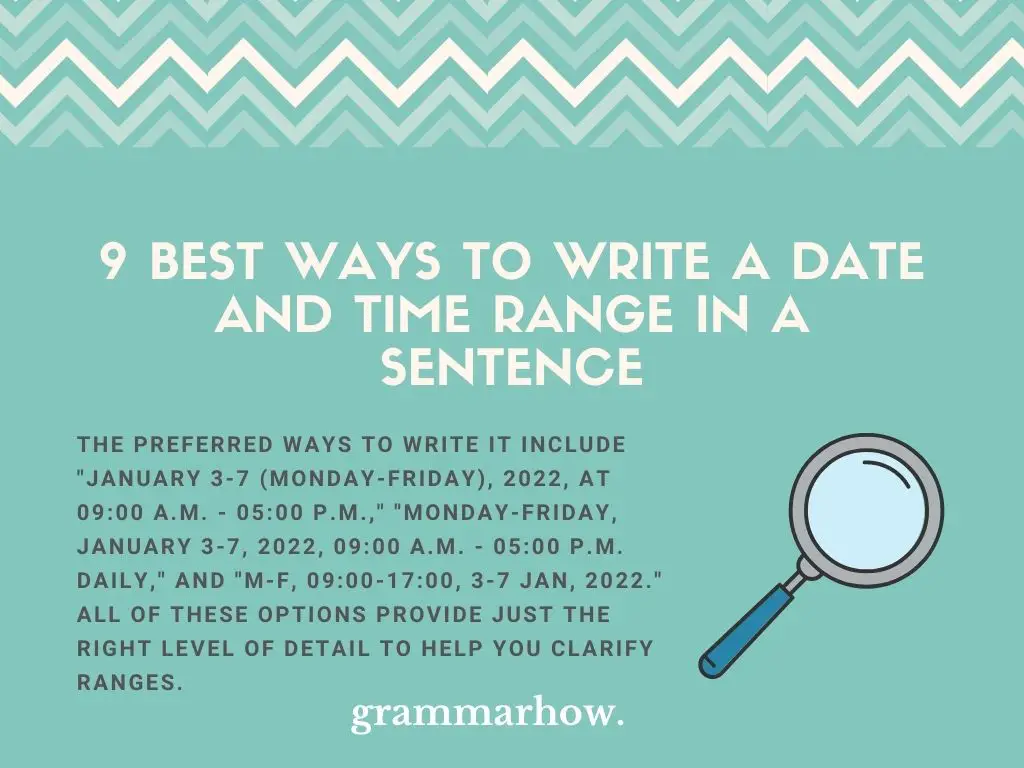
The preferred ways to write it include “January 3-7 (Monday-Friday), 2022, at 09:00 a.m. – 05:00 p.m.,” “Monday-Friday, January 3-7, 2022, 09:00 a.m. – 05:00 p.m. daily,” and “M-F, 09:00-17:00, 3-7 Jan, 2022.” All of these options provide just the right level of detail to help you clarify ranges.
January 3-7 (Monday-Friday), 2022, At 09:00 a.m. – 05:00 p.m.
This phrase is a great way of showing a time and date range. It covers all the necessary information, starting with the month and dates. From there, it goes to the specific days, the year, and the time.
Everything you could possibly need is covered when this format is used. It’s also sufficiently formal, allowing you to use it in any situation whether you’re at work or in a more informal setting.
Since every detail is covered, you’ll often find that people don’t need further clarification or information. They won’t need to miss out on the event because they’ll know exactly when it is taking place.
- I think it’s set for January 3-7 (Monday-Friday), 2022, from 09:00 a.m. – 05:00 p.m. Does that ring any bells for you?
- It’s going to have to be held on June 10-14 (Tuesday-Saturday), 2020, from 10:00 a.m. – 2:00 p.m. That’s my final offer.
- Can we do February 8-12 (Monday-Friday), 2022, at 09:00 a.m. – 12:00 p.m. That’s a good window of time for me to get this done.
Monday-Friday, January 3-7, 2022, 09:00 a.m. – 05:00 p.m. Daily
In the spirit of good detail, this phrase also works well. This time, the days of the week come first (which is more natural to most speakers). After that, the dates come, then it finishes with the time again.
This format is more traditional in spoken English. It’s common for days to come before dates because people are used to using things like “Monday-Friday” when they are casually speaking to people.
- Monday-Friday, January 3-7, 2022, 09:00 a.m. – 05:00 p.m. daily. That’s when this will be held. Be there!
- I think they said Monday-Friday, March 13-17, 2022, 09:00 a.m. – 05:00 p.m. daily. That’s about as good as it’s going to get, I’m afraid.
- You will have to be there on Wednesday-Sunday, August 20-24, 2022, 09:00 a.m. to 12:00 p.m. daily. That’s what we can offer right now.
M-F, 09:00-17:00, 3-7 Jan 2022
If you want a slightly more crisp time and date range, this phrase is a good one to use. You can abbreviate the days of the week to their starting letters (M-F). Also, it’s wise to use a digital clock when you don’t want to specify the “a.m.” or “p.m.” times in your message.
Shortening the month name (January to “Jan”) is a good way of getting straight to the point as well.
This format is great because it still covers all of the relevant information. However, it does it in a more concise way, which more people will respond to.
- I can do M-F, 09:00-17:00, 3-7 Feb 2022. What do you say about that? I think we have to settle on this right away.
- Are you going to be free M-W, 09:00-13:00, 6-10 Jun 2022? I think that’s the only time that we have on offer right now.
- I will be there M-F, 09:00-14:00, 4-8 Mar 2022. That’s about all the time we need to make sure that everything goes right here.
3-7 Jan 2022 (M-F 09:00-17:00)
This is another good way of using digital time over an analog one. Here, “January” is again shortened to “Jan” (and any month can do the same). Also, Monday and Friday are abbreviated to their starting letters, and a digital time frame is used.
It’s just another way of wording the above phrase. Some people prefer to get the dates out of the way first and then follow them with the days (rather than putting the days before the dates in the previous section).
- We’re going to go from 3-7 Jan 2022 (M-F 09:00-17:00). Do you think you’re going to be able to come along with us?
- I want to set this for 20-24 Nov 2022 (M-F 10:00-14:00). I’m not sure if there’s anything specific I need to bring, but I’m happy to learn.
- You will go from 10-14 Jul 2022 (M-F 12:00-20:00). That’s my final offer, and I expect you to follow through with my request here.
This/Next Monday To Friday Between 09:00 a.m. And 05:00 p.m.
This phrase works well when you’re speaking to someone in passing. If you’re only letting them know that something is happening, you might not need to set up a formal way for them to record the date or time range.
“This” and “next” are great ways of letting someone know the dates of something without specifying them. The assumption is that “this Monday to Friday” implies the days that come up next. “Next Monday to Friday” implies the following week after that.
As long as you know the differences between “this” and “next,” you’ll have an easy time understanding this time and date range.
- It’s going to be running this Monday to Friday, between 09:00 a.m. and 05:00 p.m. We hope that you’ll be able to come along!
- Join in! It’s next Monday to Friday, between 10:00 a.m. and 02:00 p.m. It’s going to be some of the most fun we’ve ever had around here.
- No, you’ll find it starts next Monday to Wednesday, between 12:00 p.m. and 08:00 p.m. Are you going to be able to attend?
From 3-7 January at 09:00 – 17:00 Daily
Here, the dates are reintroduced, but we’re still using a digital time frame to help people understand when something occurs. “From” is a prepositional choice that shows that something lasts between two different dates.
- I thought you said it was from 3-7 January at 09:00 – 17:00 daily! Why isn’t anything starting yet? Am I getting my dates confused?
- Yes, we’ve set it from 11-15 February at 10:00-18:00 daily. It’s going to be the most exciting event we’ve had here in a long time.
- I’ll be there from 22-26 March from 12:00-17:00 daily. I think that’s all I can manage, but I’ll see if I’m able to stick around for more.
Every Day This/Next Week
You can use “every day this/next week” when you are speaking colloquially with someone. If the week in question is already specified, then you don’t often have to take it any further than that.
People will not get confused by your meaning if you set a date like this. If you say “every day this week,” it implies that you mean every weekday (unless you specify otherwise).
- Of course, we’ve got it set for every day this week! We hope that’s going to be more than enough excitement for you.
- It’s on every day this week at the same time! Hopefully, you’ll be able to bring a few extra people along with you next time.
- You’ll find us here every day next week! Just ask for me by name, and I’ll be sure to come and help you out with it!
January 3-7, Monday-Friday, Between 09:00 And 05:00
This setting is a good choice, but you might notice that we’ve removed “a.m.” and “p.m.” It works well because it assumes that people already aspect it to run from the morning to the afternoon.
After all, saying 09:00 – 05:00 and meaning from morning to morning would be a very strange setting for an event. Most events don’t run for almost twenty-four hours, which is why you don’t always need to determine the time with “a.m.” and “p.m.” clarifications.
- We’ve set it for January 3-7, Monday-Friday, between 09:00 and 05:00. We really hope you can all make it. It wouldn’t be the same without you.
- June 13th-17th, Tuesday-Saturday, between 10:00 and 06:00. It’s the only time that we’re able to get this done, I’m afraid.
- It will be from December 20th-24th, Monday-Friday, between 07:00 and 10:00. Are you going to be able to make it or not?
The 3rd To The 7th Of This/Next Month, 09:00 – 05:00 Daily
This phrase is written out in a more streamlined way. The dash is removed and replaced with “to the.” It’s slightly more formal because of this, but it still removes the use of “a.m.” and “p.m.” because it assumes that people already understand when something runs.
- This event will run from the 3rd to the 7th of this month, 09:00 – 05:00 daily. Be there, or be square!
- We will host this from the 3rd to the 7th of next month. It’s 10:00 – 2:00 daily, so we hope you’ll be able to make it!
- The 13th to the 17th of next month will be the dates of the event. It will run from 12:00 to 3:00 daily. Will you be attending?
You may also like: 9 Best Ways To Denote Date and Time in Written English Correct Date Format by Country (UK vs. US vs. Europe)

Martin holds a Master’s degree in Finance and International Business. He has six years of experience in professional communication with clients, executives, and colleagues. Furthermore, he has teaching experience from Aarhus University. Martin has been featured as an expert in communication and teaching on Forbes and Shopify. Read more about Martin here .
- “Next Friday” vs. “This Friday”: 8 Helpful Examples (Complete Guide)
- 15 Best Replies to “Happy Friday”
- See You Monday vs See You On Monday – Difference Explained (+14 Examples)
- What Does “By Friday” Mean? (Does It Include “Friday”?)
How to Write the Date in a Paper
Rachel spradling.

Most high school and college classes require that students use Modern Language Association, American Psychological Association or "Chicago Manual of Style" guidelines when writing an academic paper. Each style is used for a different academic area. MLA style is used for languages and literature, APA is used for science and Chicago is used for the humanities. When including a date in the text of your paper, you must follow the guidelines for the style appropriate to your subject.
Review your course syllabus to determine which style guide your instructor requires. Contact your instructor if the information isn't listed and ask what style is acceptable.
If you’re writing in MLA style, list the date, month and then year. Do not use commas. For example: 14 March 1985 or March 1985.
If you’re writing in APA style, list the month, date and then year. Insert a comma after the date. For example: June 15, 2005 or May 2004.
If you’re writing in Chicago style, list the month, date and then year. Insert a comma after the date. For example: June 15, 2005 or May 2004.
- You can find hard copies of the style guides at most public libraries.
- Be aware that you need to format dates in bibliographies differently than dates appearing in text. Refer to the appropriate style guide for further direction on how to create bibliographies.
- 1 Purdue Online Writing Lab: MLA Formatting and Style Guide
- 2 Purdue Online Writing Lab: APA Abbreviations
About the Author
Rachel Spradling is a writer and editor with over 14 years of experience writing everything from political commentary to training manuals. She graduated from California State University, Chico with a Bachelor of Arts in English. Spradling's work has appeared in "CitiZen" magazine, "Watershed" and "News and Review."
Related Articles

How to Take Notes Using the Charting Method

How to Reference an Appendix Using the APA Format

How to Write the Title of a News Article in a Paper

True or False: Mars Edition

How to Write the Date in French

How to Write a Paper on Your Computer

How to Write Book Titles in an Essay

How to Insert an Image on an APA-Style Paper

How to Reference Excel Worksheets in APA Format

How to Reference a Chapter in a Book That Is Not Edited?

How to Write a Parenthetical Notation

How to Write a Proposal for a Research Paper in Chicago...

Listing Dates in Excel Excluding Weekends

How to Do Bullet Statements in APA Writing

How to Format a List in APA Style

How to Write a Table of Contents in APA Style

How to Cite the Qur'an in MLA

Define MLA Writing Format

APA Style For Quoting More Than 40 Words

How to Convert Lunar Calendar to Western
Regardless of how old we are, we never stop learning. Classroom is the educational resource for people of all ages. Whether you’re studying times tables or applying to college, Classroom has the answers.
- Accessibility
- Terms of Use
- Privacy Policy
- Copyright Policy
- Manage Preferences
© 2020 Leaf Group Ltd. / Leaf Group Media, All Rights Reserved. Based on the Word Net lexical database for the English Language. See disclaimer .

How to cite ChatGPT

Use discount code STYLEBLOG15 for 15% off APA Style print products with free shipping in the United States.
We, the APA Style team, are not robots. We can all pass a CAPTCHA test , and we know our roles in a Turing test . And, like so many nonrobot human beings this year, we’ve spent a fair amount of time reading, learning, and thinking about issues related to large language models, artificial intelligence (AI), AI-generated text, and specifically ChatGPT . We’ve also been gathering opinions and feedback about the use and citation of ChatGPT. Thank you to everyone who has contributed and shared ideas, opinions, research, and feedback.
In this post, I discuss situations where students and researchers use ChatGPT to create text and to facilitate their research, not to write the full text of their paper or manuscript. We know instructors have differing opinions about how or even whether students should use ChatGPT, and we’ll be continuing to collect feedback about instructor and student questions. As always, defer to instructor guidelines when writing student papers. For more about guidelines and policies about student and author use of ChatGPT, see the last section of this post.
Quoting or reproducing the text created by ChatGPT in your paper
If you’ve used ChatGPT or other AI tools in your research, describe how you used the tool in your Method section or in a comparable section of your paper. For literature reviews or other types of essays or response or reaction papers, you might describe how you used the tool in your introduction. In your text, provide the prompt you used and then any portion of the relevant text that was generated in response.
Unfortunately, the results of a ChatGPT “chat” are not retrievable by other readers, and although nonretrievable data or quotations in APA Style papers are usually cited as personal communications , with ChatGPT-generated text there is no person communicating. Quoting ChatGPT’s text from a chat session is therefore more like sharing an algorithm’s output; thus, credit the author of the algorithm with a reference list entry and the corresponding in-text citation.
When prompted with “Is the left brain right brain divide real or a metaphor?” the ChatGPT-generated text indicated that although the two brain hemispheres are somewhat specialized, “the notation that people can be characterized as ‘left-brained’ or ‘right-brained’ is considered to be an oversimplification and a popular myth” (OpenAI, 2023).
OpenAI. (2023). ChatGPT (Mar 14 version) [Large language model]. https://chat.openai.com/chat
You may also put the full text of long responses from ChatGPT in an appendix of your paper or in online supplemental materials, so readers have access to the exact text that was generated. It is particularly important to document the exact text created because ChatGPT will generate a unique response in each chat session, even if given the same prompt. If you create appendices or supplemental materials, remember that each should be called out at least once in the body of your APA Style paper.
When given a follow-up prompt of “What is a more accurate representation?” the ChatGPT-generated text indicated that “different brain regions work together to support various cognitive processes” and “the functional specialization of different regions can change in response to experience and environmental factors” (OpenAI, 2023; see Appendix A for the full transcript).
Creating a reference to ChatGPT or other AI models and software
The in-text citations and references above are adapted from the reference template for software in Section 10.10 of the Publication Manual (American Psychological Association, 2020, Chapter 10). Although here we focus on ChatGPT, because these guidelines are based on the software template, they can be adapted to note the use of other large language models (e.g., Bard), algorithms, and similar software.
The reference and in-text citations for ChatGPT are formatted as follows:
- Parenthetical citation: (OpenAI, 2023)
- Narrative citation: OpenAI (2023)
Let’s break that reference down and look at the four elements (author, date, title, and source):
Author: The author of the model is OpenAI.
Date: The date is the year of the version you used. Following the template in Section 10.10, you need to include only the year, not the exact date. The version number provides the specific date information a reader might need.
Title: The name of the model is “ChatGPT,” so that serves as the title and is italicized in your reference, as shown in the template. Although OpenAI labels unique iterations (i.e., ChatGPT-3, ChatGPT-4), they are using “ChatGPT” as the general name of the model, with updates identified with version numbers.
The version number is included after the title in parentheses. The format for the version number in ChatGPT references includes the date because that is how OpenAI is labeling the versions. Different large language models or software might use different version numbering; use the version number in the format the author or publisher provides, which may be a numbering system (e.g., Version 2.0) or other methods.
Bracketed text is used in references for additional descriptions when they are needed to help a reader understand what’s being cited. References for a number of common sources, such as journal articles and books, do not include bracketed descriptions, but things outside of the typical peer-reviewed system often do. In the case of a reference for ChatGPT, provide the descriptor “Large language model” in square brackets. OpenAI describes ChatGPT-4 as a “large multimodal model,” so that description may be provided instead if you are using ChatGPT-4. Later versions and software or models from other companies may need different descriptions, based on how the publishers describe the model. The goal of the bracketed text is to briefly describe the kind of model to your reader.
Source: When the publisher name and the author name are the same, do not repeat the publisher name in the source element of the reference, and move directly to the URL. This is the case for ChatGPT. The URL for ChatGPT is https://chat.openai.com/chat . For other models or products for which you may create a reference, use the URL that links as directly as possible to the source (i.e., the page where you can access the model, not the publisher’s homepage).
Other questions about citing ChatGPT
You may have noticed the confidence with which ChatGPT described the ideas of brain lateralization and how the brain operates, without citing any sources. I asked for a list of sources to support those claims and ChatGPT provided five references—four of which I was able to find online. The fifth does not seem to be a real article; the digital object identifier given for that reference belongs to a different article, and I was not able to find any article with the authors, date, title, and source details that ChatGPT provided. Authors using ChatGPT or similar AI tools for research should consider making this scrutiny of the primary sources a standard process. If the sources are real, accurate, and relevant, it may be better to read those original sources to learn from that research and paraphrase or quote from those articles, as applicable, than to use the model’s interpretation of them.
We’ve also received a number of other questions about ChatGPT. Should students be allowed to use it? What guidelines should instructors create for students using AI? Does using AI-generated text constitute plagiarism? Should authors who use ChatGPT credit ChatGPT or OpenAI in their byline? What are the copyright implications ?
On these questions, researchers, editors, instructors, and others are actively debating and creating parameters and guidelines. Many of you have sent us feedback, and we encourage you to continue to do so in the comments below. We will also study the policies and procedures being established by instructors, publishers, and academic institutions, with a goal of creating guidelines that reflect the many real-world applications of AI-generated text.
For questions about manuscript byline credit, plagiarism, and related ChatGPT and AI topics, the APA Style team is seeking the recommendations of APA Journals editors. APA Style guidelines based on those recommendations will be posted on this blog and on the APA Style site later this year.
Update: APA Journals has published policies on the use of generative AI in scholarly materials .
We, the APA Style team humans, appreciate your patience as we navigate these unique challenges and new ways of thinking about how authors, researchers, and students learn, write, and work with new technologies.
American Psychological Association. (2020). Publication manual of the American Psychological Association (7th ed.). https://doi.org/10.1037/0000165-000
Related and recent
Comments are disabled due to your privacy settings. To re-enable, please adjust your cookie preferences.
APA Style Monthly
Subscribe to the APA Style Monthly newsletter to get tips, updates, and resources delivered directly to your inbox.
Welcome! Thank you for subscribing.
APA Style Guidelines
Browse APA Style writing guidelines by category
- Abbreviations
- Bias-Free Language
- Capitalization
- In-Text Citations
- Italics and Quotation Marks
- Paper Format
- Punctuation
- Research and Publication
- Spelling and Hyphenation
- Tables and Figures
Full index of topics
- INNOVATION FESTIVAL
- Capital One
08-09-2024 HOW TO BE A SUCCESS AT EVERYTHING
How I wrote a book in 15 minutes a day
Every first novel started as an unpublished writer’s wild idea. Here’s how to make yours a reality.
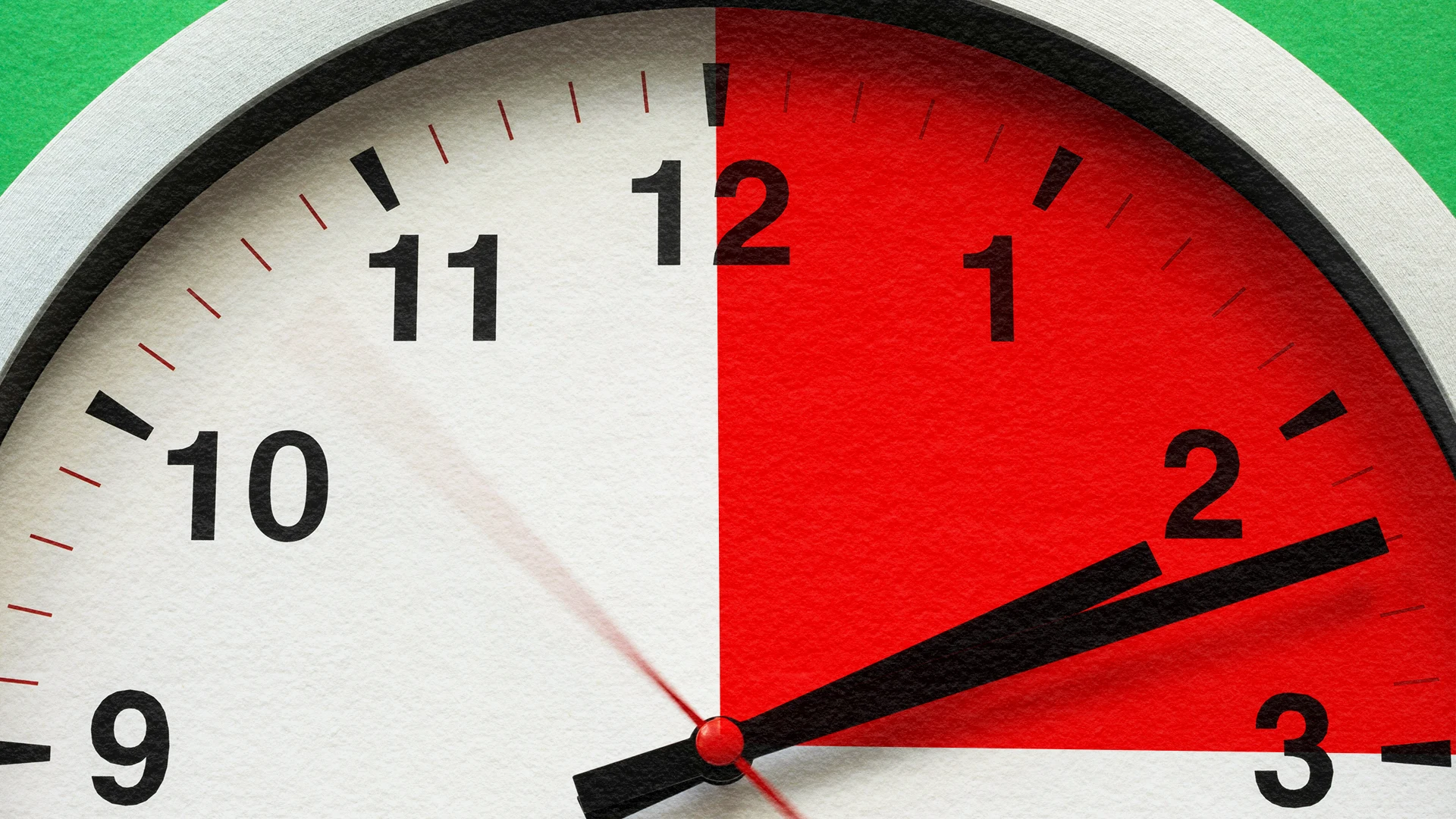
[Photo: Stas Knop /Pexels]
BY Julia Dahl 4 minute read
The first time I tried to write a novel I was 23. I had all the time in the world. I was a full-time graduate student. I lived alone, I had no children, and it took me three years to finish a draft.
Five years later, I tried again. I was working full-time as a reporter and I lived with my boyfriend, but we had no kids. This time, it took me five years.
All that time, my technique, if you could call it that, was the same: set up my laptop at a coffee shop or a library or at my desk at home, and “write.” But, as New York Times best-selling author Meghan O’Rourke recently tweeted : “It’s really important to have at least three hours to write every day so you can spend the first two hours squirming and checking the internet and daydreaming before getting down to it.”
Touché. I thought I needed hours with nothing to do but write. But even with all those hours, I didn’t produce much. So I started applying for retreats and residencies , thinking maybe I needed long stretches—days, weeks—to do nothing but write.
I wrote three novels that way. Fits of progress followed by long lulls of nothing. And then I had a child.
Suddenly, there were no long stretches.
I struggled. I had to figure out a way to fold my writing back into my life, but my life had changed so dramatically I wasn’t sure how. I turned in my fourth novel two years past the deadline. I had an idea for another, but no idea how I’d actually get it gone.
And then, my friend, author Laura McHugh, told me she’d started doing “writing sprints.” I don’t have all day, she told me, but I can commit to one hour.
Frankly, an hour felt impossible, but I liked the idea of a sprint. I turned off my Wi-Fi, silenced my ringer, put on some noise-canceling headphones, and for 15 minutes, I wrote. I didn’t produce a lot, but it was more than I’d done the day before. More than I’d done in a month. I did the same thing the next day, and the next. And less than two years later, I had a solid draft.
Words add up
There is nothing magic about 15 minutes—and yet there is. We all waste 15 minutes every day scrolling on our phones. Probably more, but definitely 15. And in 15 minutes, if you can write 100 words, you can have a full-length draft of a novel in two years. (One hundred words times 365 days times two years is 73,000 words, which most editors will tell you is on the shorter end of average novel length.) You’ll also probably start enjoying those 15 minutes; what you accomplished will help carry you through the day. And sometimes those 15 minutes will turn into longer sessions.
Will what you write be ready to publish? No. First drafts never are. Part of the 15 minute technique is to give yourself permission to write badly. You’ll fix it later. But here’s the key: There is no published novel without a finished first draft. What if two years ago you’d decided to write 15 minutes a day? You’d have hundreds of pages to polish into something publishable.
Training your brain
But more than the words on the page—which add up!—the genius of the 15 daily minutes is that the real secret to writing a novel, or achieving any long-term artistic goal, is time spent thinking about the thing you’re creating. You can’t write a novel without hours and hours spent considering the world you’re building, the people you’re creating, the problems they’ll encounter, and the route it will take for them to get to the end of their journey.
To do all that, you need to spend a lot of time walking around with the novel in your brain. Spending even just 15 minutes each day “with” your novel means that it will always be present in your mind. Nurture that presence when you aren’t writing. Cut down on podcasts when you’re walking or driving. Give yourself quiet. Tell yourself: I’m going to think about the next scene I need to write while I go through this car wash, or walk to the grocery store, or wait for my son’s lacrosse practice to end.
Keep a notebook with you to jot down plot ideas and snippets of dialogue. Or, use your phone to dictate messages to yourself, though your phone can be very dangerous as a distraction, so beware.
How to find your 15 minutes
It’ll be different for everyone. You can’t get me out of bed one minute before I need to be awake, so mornings are out for me. And once I’ve put my son to bed, I’m pretty wiped. It’s certainly not my most creative time. So I do my 15 minutes in the middle of the day.
I coach novelists who do their 15 minutes after their morning workout, or after they’ve dropped their kids off from school, or right before bed. I know writers who write at work on their lunch break. All that matters is the time; the where and when can change as your life does.
Give yourself permission
Let me tell you a secret: Most writers—even those with books in your favorite bookstore, reviewed by the big papers—don’t make enough money off their writing to pay all their bills. The same is true of all other artists: musicians, painters, actors, dancers. Does that make their work less legitimate? If you write, you’re a writer. Own it.
Another thing to remember is that every novel you pick up (and every song you listen to, every performance you attend) started as somebody’s wild idea. It exists only because its creator decided to spend unpaid time working on it. Little by little, the wild idea turns into something real.
Apply to the Most Innovative Companies Awards and be recognized as an organization driving the world forward through innovation. Early-rate deadline: Friday, August 23.
ABOUT THE AUTHOR
Julia Dahl is the author of five novels including I Dreamed of Falling , out this September from Minotaur Books. She teaches journalism at NYU and provides private coaching and creative writing classes online . More
Explore Topics
- Tech U.S. awards chipmaker Texas Instruments up to $1.6 billion to build factories
- Tech Influencers explain how Kamala Harris’ campaign won TikTok
- Tech Kim Dotcom loses 12-year battle to halt deportation to U.S.
- News Housing affordability is crushed. Kamala Harris just unveiled a plan that would make it worse
- News Barnes & Noble is opening 58 stores in 2024: Here’s a full list of cities that will get new locations
- News Gen-Z’s top car must-haves: comfort and CarPlay
- Design The Lamborghini Temerario’s headlights hide a performance boost
- Design Chicago is known for public art. At the DNC, local artists will be on full display
- Design The brand winners and losers of the 2024 election (so far)
- Work Life Here are tips to retire abroad and expert investment advice
- Work Life In praise of process innovation, the idea economy’s behind-the-scenes workhorse
- Work Life This is how you develop (and rekindle) workplace friendships
Skip to Content
Other ways to search:
- Events Calendar
Want to write a college essay that sets you apart? Three tips to give you a head start

1. Keep it real. It’s normal to want to make a good impression on the school of your choice, but it’s also important to show who you really are. So just be yourself! Compelling stories might not be perfectly linear or have a happy ending, and that’s OK. It’s best to be authentic instead of telling schools what you think they want to hear.
2. Be reflective . Think about how you’ve changed during high school. How have you grown and improved? What makes you feel ready for college, and how do you hope to contribute to the campus community and society at large?
3. Look to the future. Consider your reasons for attending college. What do you hope to gain from your education? What about college excites you the most, and what would you like to do after you graduate? Answering these questions will not only give colleges insight into the kind of student you’ll be, but it will also give you the personal insight you’ll need to choose the school that’s right for you.
Have questions about college prep? We're here to help.
Written by CU Boulder Office of Admissions
- College-Prep
The University of Colorado does not discriminate on the basis of race, color, national origin, sex, age, pregnancy, disability, creed, religion, sexual orientation, gender identity, gender expression, veteran status, political affiliation, or political philosophy. All qualified individuals are encouraged to apply. You may view the list of ADA and Title IX coordinators and review the Regent policy .
As a student or prospective student at CU Boulder, you have a right to certain information pertaining to financial aid programs, the Clery Act, crime and safety, graduation rates, athletics and other general information such as the costs associated with attending CU Boulder. To view this information visit colorado.edu/your-right-know .
Apply for Admission
Visit Campus
Support CU Boulder
- Safety & Health Services
- COVID-19 Information
- Campus Communications
- Emergency Alert System
- New Student & Family Programs
Getting Around
- Campus Events
- Parking & Transportation
- Visit Information
Information for
- Faculty & Staff
- Journalists
Initiatives
- Business & Industry Collaborations
- Diversity, Equity & Inclusion
- Free Speech
- Innovation & Entrepreneurship
- Public & Outreach Programs
- Sustainability
- Understanding Your Cost of Attendance

IMAGES
COMMENTS
Many people get confused about how to write dates with commas, so here is a rule of thumb: in the month-day-year format (used in the United States), place commas after the day and year. In the day-month-year format (used in the UK and other countries), do not use commas at all. On May 13th, 2007 Daniel was born. On May 13, 2007, Daniel was born.
Day + Month + Year (e.g., 21 April 2016) Numbers Only (e.g. 21/04/2016) There are also variations to how these can be presented, such as using an ordinal suffix after the day. These are the letters we'd use if we were writing the number out in full and are often written with a superscript font:
Here are 21 ways to write the date, explained in detail with examples. 1. Formal English. In formal English, especially in business or academic writing, the date is typically written in full to avoid ambiguity. This format includes the day of the month, the month spelled out in full, and the year.
First, write the month, then the day, and then the year. Examples are: Sep 10. September 10. 09/10/2022. When using American English, separate the day and the year using a comma. If you are including the weekday, place a comma after it as well. A comma is not required if you are using British English.
Note that the year follows after a comma. You can, however, use a few different formats. This can include omitting the year or adding the day of the week. In addition, you can use ordinal instead of cardinal numbers when writing the date out in full with the day before the month: Thursday, October 3. Tuesday, August 6, 2019.
Shortening the year is also acceptable as long as it will be clear which year you mean, such as in the following: 23.10.16. 23/10/2016. You can also write out the date but shorten the month to save space: 14 January 2016 → 14 Jan 2016. 9 October → 9 Oct. Although these options are easy to understand and perfectly acceptable in most writing ...
Writers should write out the month, give a space before writing the numeral for the day, follow that with a comma and space, and then, write the numeral for the year followed by a period. Correct: Jaws was released in the United States on June 20, 1975. Incorrect: Jaws was released in the United States on June 20 1975.
When you need to write the entire date, place a comma after the day. Here's what it looks like: July 4, 1776. When we see the date, we read the day in our heads, or out loud, as ordinal numbers. However, it's not necessary to actually use ordinal numbers (e.g. 4th) when you write the day.
To write the exact date, spell out the month, and write the day and the year in numerals. The American date format is month-day-year, with a comma between day and year (May 1, 2022), while the British format is day-month-year, with no comma between month and year (1 May 2022).Don't use ordinal numbers in dates in formal texts (May 1st, 2022).You may also show the day of the week (Sunday, May ...
Dates are typically written in the order of day - month - year in British English. When you're writing the year in words, in British English, you write and after thousand when discussing a year after 2000. If you're adding the day of the week to the date, it comes before the date. You should separate the name of the day from the date by ...
Month Abbreviation. When formatting dates in MLA style, use the abbreviated form of the month followed by a period. The month abbreviations are as follows: January → Jan. February → Feb. March → Mar. April → Apr. May, June, and July remain as they are. August → Aug.
In the main text, dates are presented differently. The main difference is that you shouldn't abbreviate the names of months in the main text. This is done in the Works Cited list to save space, but it's not appropriate elsewhere. Additionally, dates don't have to be presented in day-month-year order in the main text.
In Europe and the UK, for example, the most common format is day-month-year. Examples: Her date of birth is 29/11/1994. Today is 26 September 2019. Note in the example above that when using the day-month-year format, you should not include a comma between the month and year. In Asia, most countries use the year-month-day format.
In this video I breakdown the different ways of writing the date in your document depending on the context.Read through our best essay resources on the Proof...
American English date format. The date format in American English is Month-Day-Year. Similar to British English, the month is written in words and the day and year with numbers. Unlike British English, there is a comma used before listing the year. When using only numbers to write the date, it's written as MM-DD-YYYY.
4. Include "the" and "of" when spelling out dates in British English. If you are writing out the date in sentence format, place "the" before the day and "of" before the month. It's important to use both together, and not just one or the other. Correct possibilities include: [4] The 9th of October.
Write the assignment due date in the month, date, and year format used in your country (e.g., Sept. 10, 2020). Title page line spacing. Double-space the whole title page. Place the paper title three or four lines down from the top of the page. Add an extra double-spaced blank like between the paper title and the byline.
Again, we'd recommend sticking with standard fonts and sizes—Times New Roman, 12-point is a standard workhorse. You can probably go with 1.5 or double spacing. Standard margins. Basically, show them you're ready to write in college by using the formatting you'll normally use in college.
Indeed, within British English itself dates can be written in more than one format. It is quite important to write dates correctly in your academic papers. Let's delve into how dates should be used or written in academic texts - with some illustrative examples: 15 May 2022. May 15, 2022. Sunday, May 15, 2022. Sunday, 15 May 2022. 05/15/22. 15 ...
Writing date and time ranges don't have to be challenging in your writing. Some people are worried about them because they often include numbers (i.e. "June 13th"), but you don't have to be alarmed. This article will demonstrate the best ways to write date and time ranges. The preferred ways to write it include "January … 9 Best Ways to Write a Date and Time Range in a Sentence ...
Learn how to write the date in different parts of the world and various situations. Find out when to use a comma and when to abbreviate. ... In very formal situations, such as invitations or business letters, you may need to write the date in words. You can do this properly in a couple of ways: The fifth of June two thousand twenty; June fifth ...
4. Past, After, Till, and To. When writing the time as words, use "after," "past," and "to" for intervals between hours. You can combine these terms with either numbers or the words "half" and "quarter" depending on the time in question: Use after or past for intervals up to half an hour past the hour. Use to for any ...
Most high school and college classes require that students use Modern Language Association, American Psychological Association or "Chicago Manual of Style" guidelines when writing an academic paper. Each style is used for a different academic area. MLA style is used for languages and literature, APA is used ...
Let's break that reference down and look at the four elements (author, date, title, and source): Author: The author of the model is OpenAI. Date: The date is the year of the version you used. Following the template in Section 10.10, you need to include only the year, not the exact date.
The first time I tried to write a novel I was 23. I had all the time in the world. I was a full-time graduate student. I lived alone, I had no children, and it took me three years to finish a ...
Writing the personal essay for your college application can be tough, but we're here to help. Sometimes the hardest part is just getting started, but the sooner you begin, the more time and thought you can put into an essay that stands out. Check out some tips: 1. Keep it real.